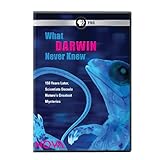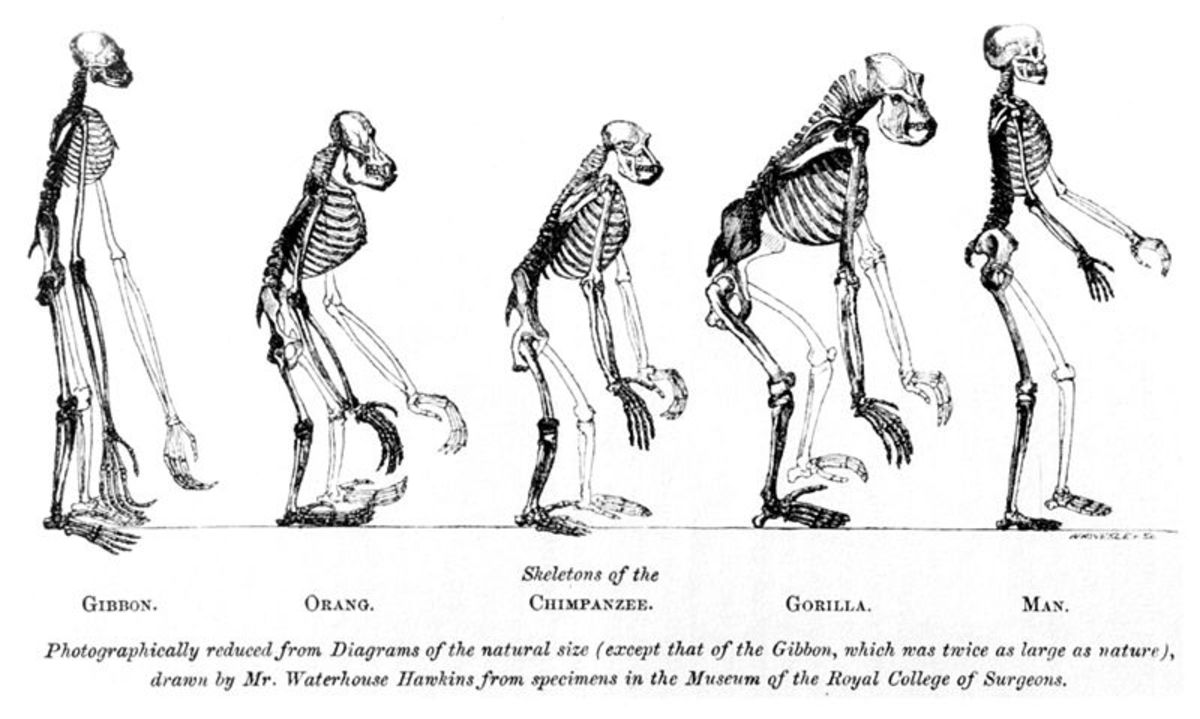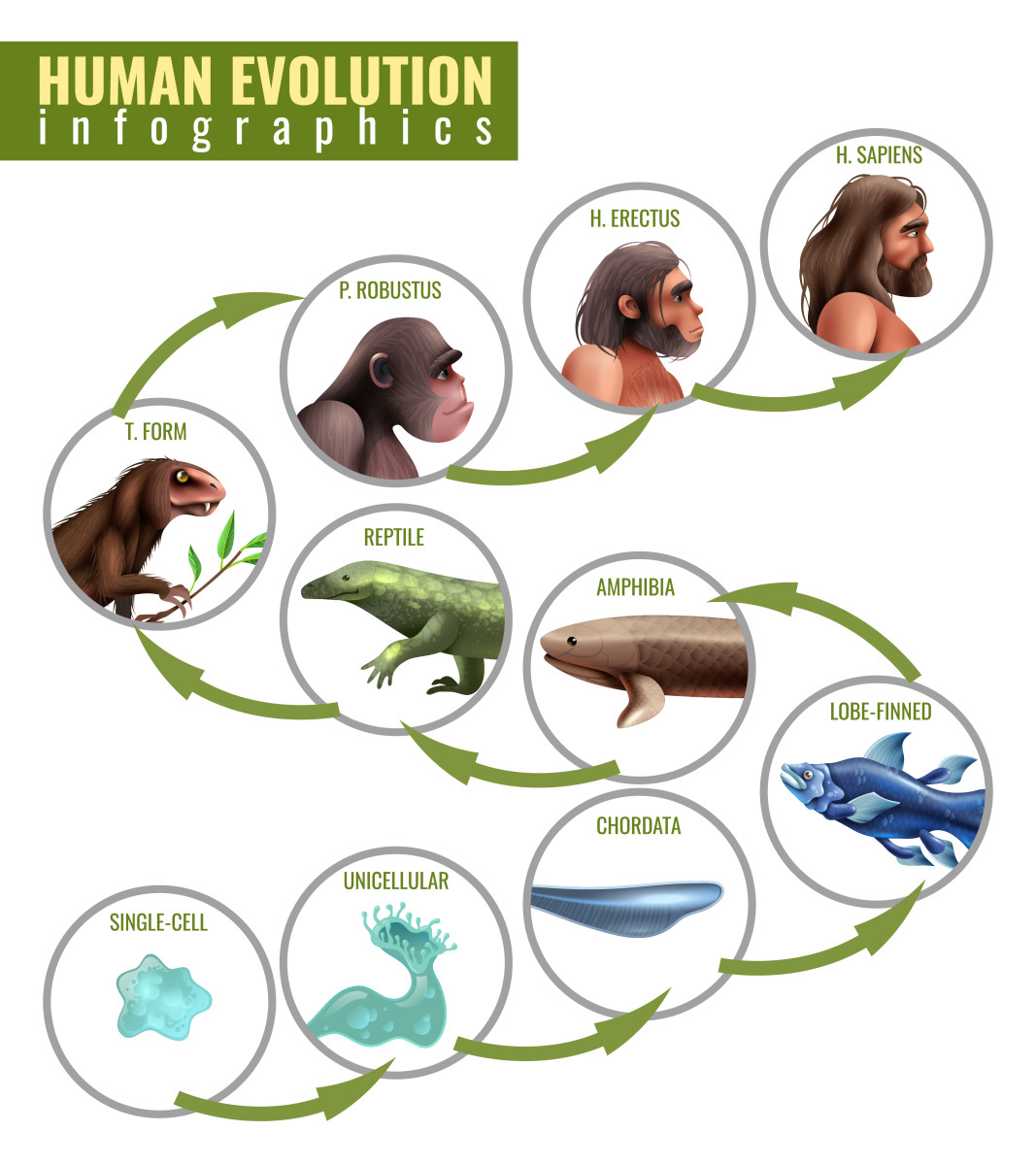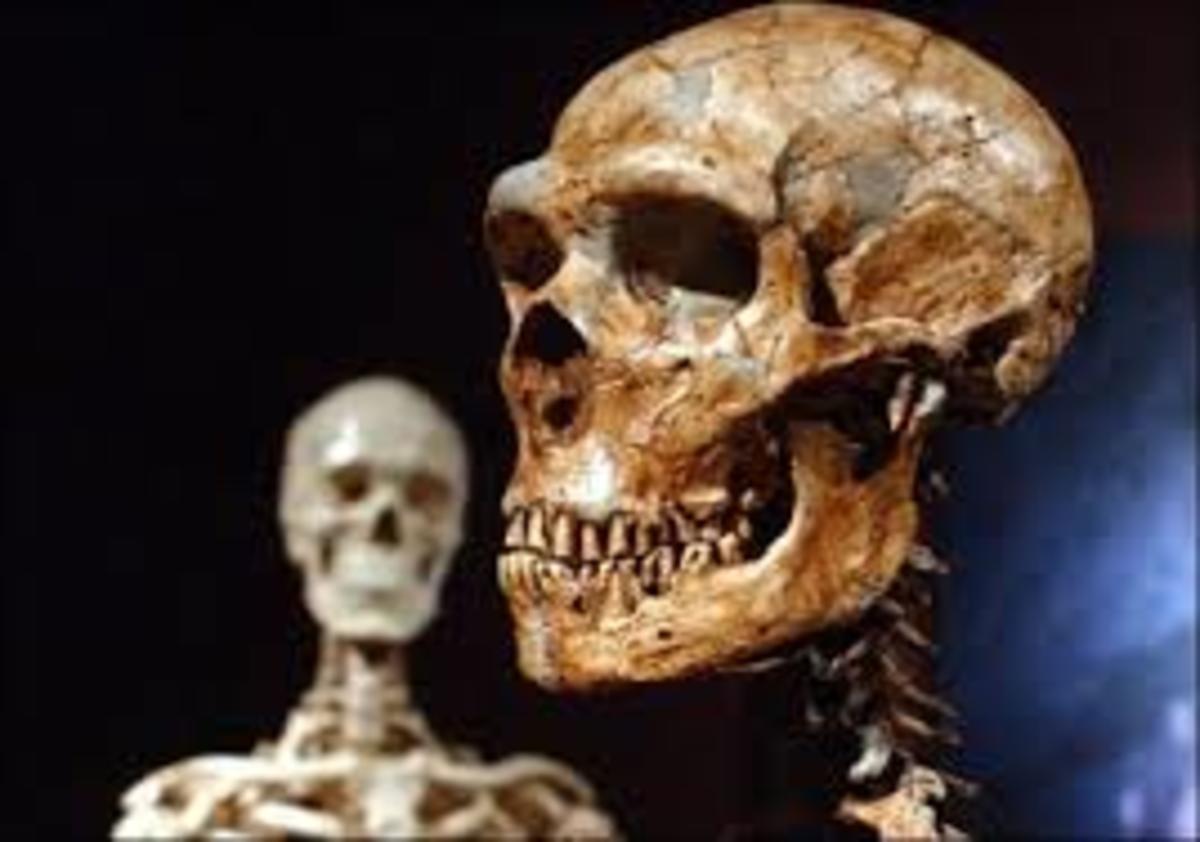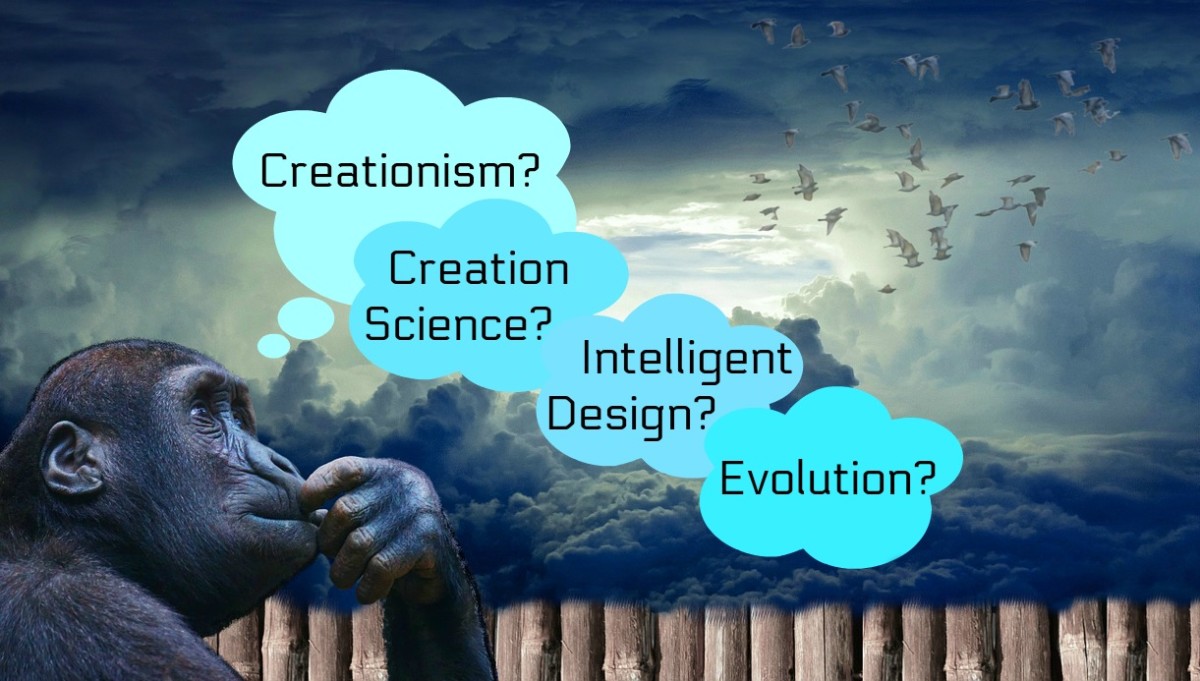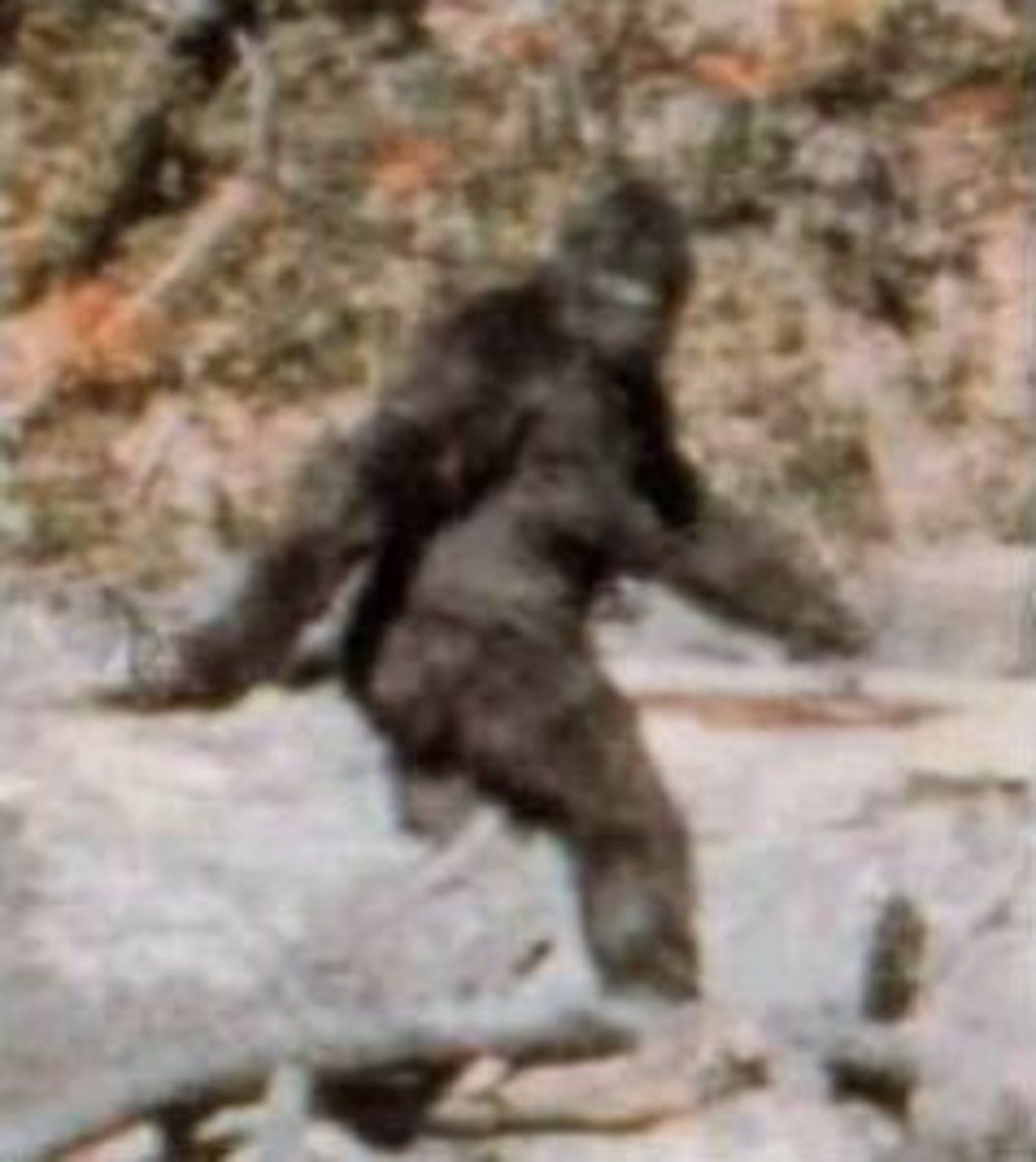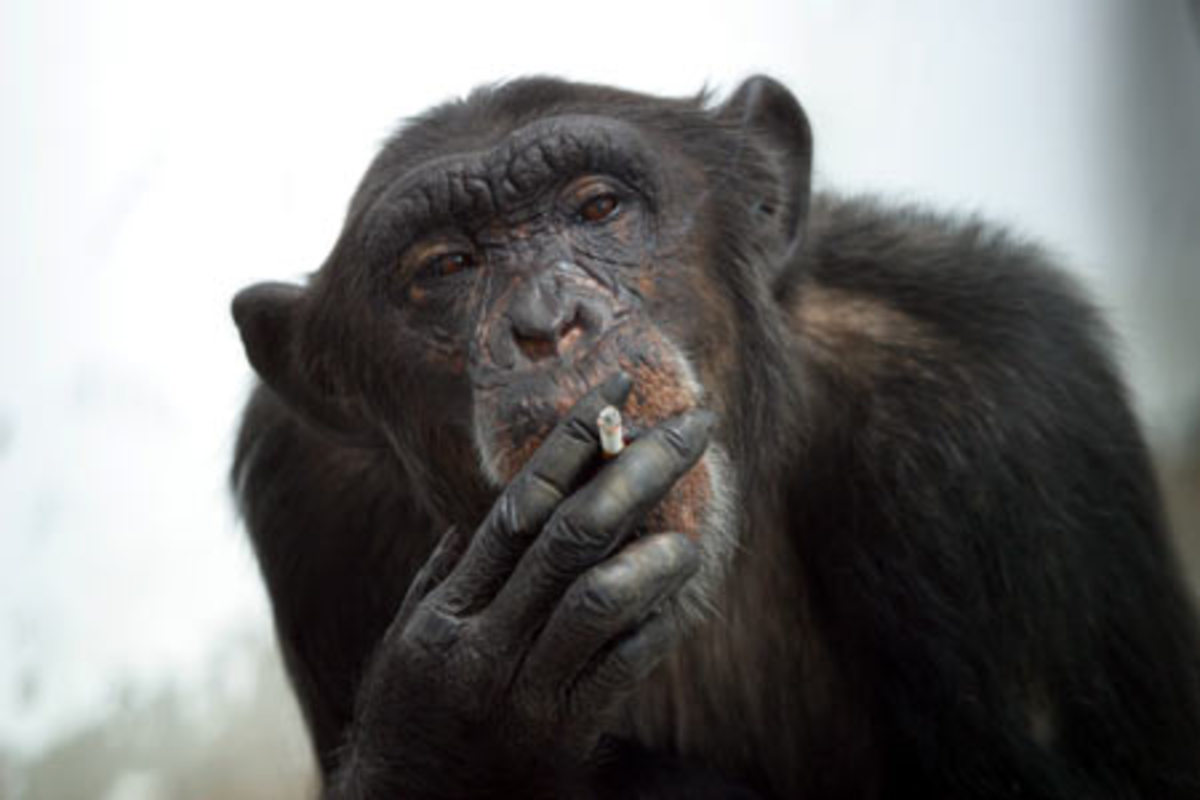Evolution and Creationism - The Never-Ending Debate
Charles Darwin: Darwin Evolving!
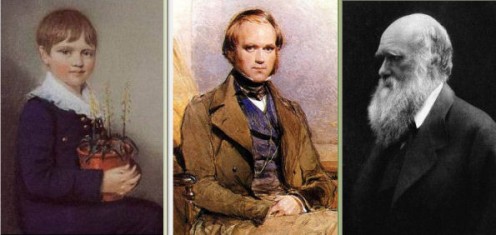
Darwin Anniversary
On 12th February, 2009, it was a case of: 'Happy 200th Birthday Mr Darwin!'
Yes, Charles Darwin was born on 12th February 1809 ~ over two centuries ago ~ and still people argue over his ideas, and malign him personally!
Can creation and evolution co-exist?
Evolutionists versus Creationists ~ who will win this great debate?
Or does there have to be a winner? ~ Can't we all just agree to disagree?
Article: Copyright Tricia Mason (Trish_M)
My Evolution Hubs
- The Facts of Life: Reproduction and Evolution
If all babies develop from a single cell, then maybe all humans evolved from a sinle-celled organism. - Evolution - The Human Difference
If we are so closely related to chimps, why is it that we seem to be so different?! - Evolution - Creationists Right and Darwin Wrong ??!!
Could the Creationists actually be correct? ~ Some arguments, including those given on the Nat Geo documentary. - Evolution - Could the Creationists Have Got It Right ??!!
Let's examine the Bible. - Brain Size, Evolution and Usage
Have we really evolved a brain, of which we use only a small percentage?
A Note from the Author: My Quest
Where do I come from? Why am I here? What is the origin of life? Should we look to science or to the Bible for answers? Or both? Did God create us, or did we evolve from simple sea creatures? Are we related to apes, or especially made in God's image? 'Darwinism' or Genesis?
I am not a scientist, but I have always found the sciences completely fascinating. However, it was only Biology that I pursued to O' Level ~ my favourite part of the syllabus being 'genetics'.
I have long wondered about the origins of life on Earth ~ but where was I to look for information on the beginning of mankind ~ the beginnings of life?
My Bible started with 'In the beginning', so, first, I looked there for answers. (I was then a Christian with doubts, but I am currently agnostic).
This is an enormous subject and I want to include all relevant points. I cannot add everything that is related ~ that would be impossible.
I know that it is a topic which dear to people's hearts. I am studying it because it interests to me so much. I hope not to offend anyone .
I apologise for any errors that I may have made ~ I would welcome corrections, questions and comments. :)
This article was originally published on HubPages as:
'Evolution and Creationism - My Take On Them and How I Arrived Here'
Tricia Mason
PS.
If you make it to the very end of the page, you will find some gorilla-sized treats : )
* * "In the Beginning God Created the Heaven and the Earth" * * The Planet Earth ~ And Earth-Rise
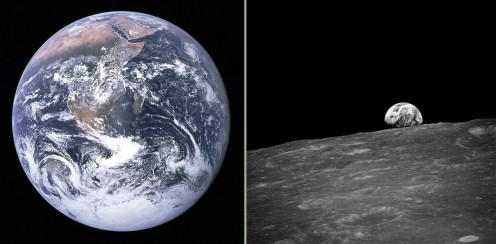
In The Beginning ~ The Creation of Man (Again!)
Genesis II (King James Version)
... on the seventh day God ended his work .. and he rested ... every plant ... was in the earth ... and there was not a man to till the ground. ........
the LORD God formed man of the dust of the ground, and breathed into his nostrils the breath of life; and man became a living soul. ... God planted a garden .. in Eden; and there he put the man . .......
And the LORD God said, It is not good that the man should be alone; I will make him an help meet for him. And .. God formed every beast of the field, and every fowl of the air; .... but for Adam there was not found an help meet . ..
And the LORD God caused a deep sleep to fall upon Adam, and .. he took one of his ribs, and closed up the flesh .. And the rib, which the LORD God had taken from man, made he a woman, and brought her unto the man.
In The Beginning ~ The Creation of Man
Genesis I + II (King James Version)
~ Genesis I
"In the beginning God created the heaven and the earth" ... in five days and he was pleased ..
God said, Let us make man in our image, after our likeness: and let them have dominion... upon the earth. ..
God created man in his own image, in the image of God created he him; male and female created he them. ..
God blessed them, and God said unto them, Be fruitful, and multiply, and replenish the earth, and subdue it: and have dominion ....
~ Genesis 2
... the heavens and the earth were finished ....
on the seventh day God ended his work ... and he rested ...
Malmsbury Bible and Family Bible - Literally the Word of God?

Genesis
Compare the 'Enuma Elis'
Genesis contains two creation stories, which compare with other Near-Eastern creation myths, the first with the 'Enûma Eliš'; the second with the 'Atra-Hasis'.
Here are the first few lines from the 'Enûma Eliš':
'When skies above were not yet named
Nor earth below pronounced by name
Apsu, the first one, their begetter
And maker Tiamat, who bore them all
Had mixed their waters together,
But had not formed pastures, nor discovered reed-beds''
This story mentions Adapa (cf 'Adam') who 'obtains wisdom .. but is forbidden the 'food of immortality' ...' and Ningishzida ~ a 'serpent deity associated with the underworld .. often depicted .. around a tree ..'
The Enuma Elish can be purchased online at Amazon. Their 'product description' states that this 'Babylonian version of the story of creation, predates much of the Book of Genesis'. It continues that, having been 'passed down orally for generations until finally being recorded on seven clay tablets, this epic was discovered by 19th-century archeologists among the ruins of the Library of King Ashurbanipal in modern-day Iraq.'
For more details, see:
http://en.wikipedia.org/wiki/Genesis_creation_narrative
Adam and Eve and Ningishzida the Snake-God

Adam and Eve
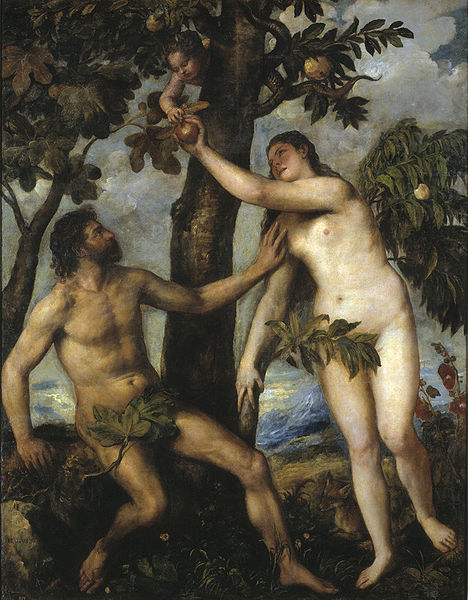
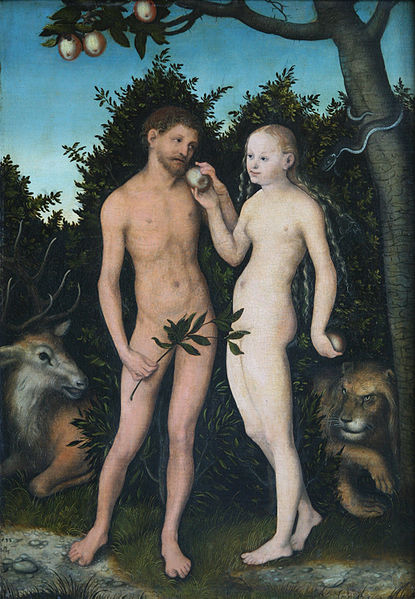
Biblical Implications Regarding Creation
The 'Biblical' creation of man is described twice, implying that two similar ~ not identical ~ creation myths were melded together here.
The first version indicates that God made all of the animals, and then both male and female humans, at the same time, before the day of rest.
The second version indicates that the male ~ Adam ~ was made after the day of rest ~ alone. Later, he was 'anaesthetised', while one of his ribs was taken by God, and moulded into a woman.
Both versions cannot be correct. How could this 'error' have occurred, if the Bible were the very word of God and its writing and editing supervised by God?
If the Bible is the word of God ~ then everything in it should be obviously clear, with no contradictions and no room for misunderstanding. This is not the case.
Creationists state that this story is an ultimate truth, directly from God ~ a truth that is more obviously correct than evolution ~ yet, here, one is left wondering what exactly happened!
Education was not the norm when Genesis was written. To be able to write, and to devise these ideas, shows a high level of knowledge, intelligence and education. Whoever the scribe and the dictator were, I respect their learning.
However, when I looked to my Bible for answers, the results were not very satisfying.
*
I will just add that the New International Version does actually present the story / stories in a more logical manner:
From 'Genesis 2' (New International Version, ©2010) ~ The 'second version' of the creation of man:
'4 This is the account of the heavens and the earth when they were created, when the LORD God made the earth and the heavens.
5 Now no shrub had yet appeared on the earth and no plant had yet sprung up ....Then the LORD God formed a man from the dust of the ground and breathed into his nostrils the breath of life, and the man became a living being.'
Source: Biblegateway.com
Genesis
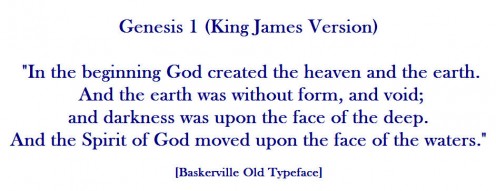
Bibles and Genesis
In His Own Image?
Assuming that God exists, what does God look like?
The Bible says that he created Adam and Eve (or maybe just Adam?) in his own image. Since Adam and Eve were, supposedly, the ancestors of all humans, he must look like us ~ or must he?
This actually leads to a dilemma ~ ~ which particular 'humans' were actually made in the image of God?
The Biblical implication is that there was one ~ and only one ~ first human couple. Was it us ~ Homo sapiens?
If so, how do earlier humans fit into the picture?? ~ Homo ergastor, for example?
Either 'we' were the first humans or we were not.
If we state that we were the first humans ~ made in the image of God ~ then we would have to pretend that earlier people did not exist. That would be living a lie.
If we accept that there were other humans before us, and that Adam and Eve belonged to that human group, then ..........
But wait ...! Which group would that be? What species of early human did God create, when he created Adam and Eve?
If Adam and Eve belonged to an earlier human group ~ a different species ~ then how did we modern humans get here?
We must have evolved from this earlier species, made at 'the Creation', because, even if God made those very 'first humans' ~ whichever humans we choose to acknowledge as the first ~ they were not the same as us. And it was they who would have been made in God's image.
No, the Bible does not adequately answer my queries.
Adam's Rib Quote - David Attenborough

Alternatives that have been suggested
Christian Creationists believe that the God of the Bible created our world and everything in it ~ including humanity, as described in the Bible.
Others believe that God was behind creation, but that the Biblical description is symbolic.
Other cultures have believed in alternative versions of creation, often related to their own 'gods'. Many cultures have had a creation myth.
Some people have suggested that man was somehow 'modified' to become a special creature by advanced aliens, who were mistaken for gods.
Evolutionists acknowledge an uncertainty as to how life began, but believe that life ~ including man ~ has evolved from simple to advanced organisms, over millions of years. This is based on evidence that has been studied scientifically.
Creation of Adam - Sistine Chapel - Michelangelo

My Early Conclusions
The Biblical explanation, for life the universe and everything, did not satisfy my desire for answers ~ not with its two versions; its similarity to other creation myths; its man made of clay and its woman made of Adam's spare rib.
What would be satisfactory??? ~ The 'Theory of Evolution' seemed to fit the bill.
The Earth, As Seen From Apollo 17 - God's Creation?

School Lessons
I was aware of evolution whilst still a child. My father accepted it as true and I read books that related to it.
I was actually taught the Theory of Evolution in a Biology course at senior school. During the appropriate lesson, our Religious Education teacher joined us. He was an Anglican priest.
To the best of my recollection, our Scripture teacher said that he considered it perfectly possible to balance belief in Creation by God with acceptance of the Theory of Evolution.
He said that the story of Adam and Eve could have been symbolic of the origins of life on Earth and that God could have created life, which then evolved into what we have on Earth today.
At School We Learned About Both Creation and Evolution - But Not Both in Science Lessons

Reproduction, DNA, Inheritance and Simple Genetics
I think that my basic knowledge of Genetics helped me to understand the Theory of Evolution. This is, basically, what we were taught:
Humans reproduce sexually.
During sexual intercourse, the male produces a large number of small, tadpole-like, male reproductive cells ~ sperm.
If the female party is ovulating, then one sperm may fertilise the relatively large, female reproductive cell ~ the ovum or egg.
Fertilisation takes place within the female body.
A fertilised egg is called a zygote.
This is the beginning of a new life and has the potential, after cell division and multiplication, to develop into a baby.
The egg is a single cell.
The sperm is also a single cell.
A cell is the 'building block of life' and a human body is made up of trillions of them. (An amoeba, on the other hand, is a single-cell creature.)
Amongst other vital components, each cell contains genetic information ~ DNA (deoxyribonucleic acid).
All human cells, except the sperm and the egg, contain 46 chromosomes each ~ that is 22 pairs of autosomes, plus one pair of sex chromosomes. These are the 'X' and 'Y' chromosomes ~ which determine gender.
The sperm and the egg have only 22 autosomes, each, plus one sex chromosome ~ either 'X' or 'Y'. When they merge as one cell, after fertilisation, they will have the usual set of 23 pairs of chromosomes.
Females produce only female gender chromosomes ~ the 'X'.
Males may produce either male or female gender chromosomes ~ 'Y' or 'X'. Thus it is the male ~ the father ~ who determines the sex of the child.
The 'X' and 'Y' chromosomes decide the gender of the new child ~ and information on the other chromosomes will decide the traits that the child will inherit.
If a child inherits two 'X' chromosomes, she will be female. If the child inherits an 'X' and a 'Y', he will be male.
Chromosomes are basically DNA molecules.
Traits are inherited via the genes.
Genes are found on chromosomes.
Chromosomes have pairs of genes at specific places (loci).
Each member of that gene pair is called an allele. Each allele in the pair will carry trait information. (There may be more than two alleles affecting particular traits.)
For various potential traits, a child inherits two alleles ~ one from each parent.
One example was always considered to be eye colour. If the child received a blue allele from one parent and a blue allele from the other, then the conclusion was that he would have blue eyes. If a child received a brown allele from one parent and a blue allele from the other, then the conclusion was that the dominant brown would hide the recessive blue, and that he would have brown eyes. However, it has been discovered that eye colour and its inheritance is more complex than was once thought. (Also with hair colour.)
As Wikipedia notes, 'eye color is a polygenic phenotypic character and is determined by two distinct factors' [ http://en.wikipedia.org/wiki/Eye_color ] and 'a polygene, multiple factor, multiple gene inheritance, or quantitative gene is a group of non-allelic genes that together influence a phenotypic trait'. [ http://en.wikipedia.org/wiki/Polygene ]
Thus, though this pattern of inheritance is valid, it is not always as simple as 'dominant' and 'recessive', when it comes to to the eyes.
All traits, visible and invisible, eg hair colour, or the tendency to an illness, are inherited in the same, or a similar, way, but for some traits it is more complex than for others.
[Edited 20 Aug 2012 to give updated information.]
The Blue-Eyed, Blonde-Haired Lady
How can we trace our genes back to one person but no further, given that this person would have had ancestors of his / her own?
This is just an example ~ a very simplistic, explanatory example.
Imagine a blue-eyed lady, of delicate build, with straight blonde hair and fair skin.
Imagine that she marries a big strong rugged man, with dark curly hair, dark brown eyes and dark skin.
The traits that she exhibits are 'recessive', while those that he exhibits are 'dominant'.
Of course, it is possible that a man of this description could carry some recessive genes (aka alleles), if his mother was fair, for example, but, for the sake of this example, imagine that all of the traits carried in her genes (aka alleles) are recessive, while all of those carried in his are dominant.
*
Their children:
What will the children of this couple look like?
The father will pass on only dominant alleles/genes, because he only carries dominant alleles/genes ~ having inherited them from both of his parents.
The mother will pass on recessive alleles/genes, because she only carries recessive alleles/genes.
Their children will inherit one allele per trait from each parent, so they will inherit one trait from each parent.
In this simplistic example, the only option is for children to inherit one recessive and one dominant trait.
Dominant traits dominate, so the children will appear to have inherited only the father's traits. The mother's recessive traits will, in effect, be hidden.
*
Their grandchildren:
What about when the 'children' reach adulthood and each seeks a mate?
What if one of the 'children' pairs up with a partner like himself ~ someone who carries all of the dominant and all of the recessive traits?
It is possible that two recessive traits might be inherited by his baby. This would be termed a 'recessive back cross'.
The 'recessive back cross' can mean that two dark, rugged parents could give birth to a dainty, blonde, blue-eyed babe. In our example, this would be just like the grandmother!
In the example, there would be a only a one in four chance of a baby inheriting two recessive alleles ~ and, in real life, the chance of him inheriting all recessive alleles would be much, much lower!
This baby would be more likely to look like its rugged ancestors than like its fair grandmother.
What if a 'child' pairs up with a partner who carries only dominant alleles?
There would be a 100% chance of a baby inheriting at least one dominant trait.
There would be a 50% chance of a baby inheriting only dominant traits
There would be a 50% chance of a baby inheriting a recessive trait.
The baby would look like its rugged ancestors ~ not like its fair grandmother.
*
Their great-grandchildren:
Moving on to the next generation ~ what if a child, who carried only dominant traits, grew up and paired up with a partner, who only carried dominant traits? Then all of their children could inherit only dominant traits.
Therefore, none of the blue-eyed, blonde haired lady's recessive alleles could possibly be inherited. All of her traits would have been bred out. It would be as if she had never existed. Anyone researching the genetic family line would not be able to find her.
The blue-eyed, blonde haired lady would have existed; she would have been an ancestor ~ but the genetic evidence for her would have disappeared.
*
North Europeans
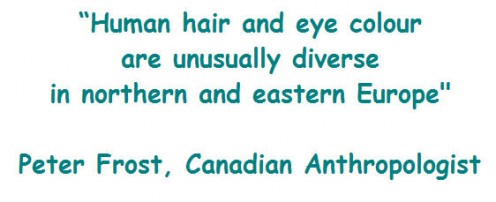
Blue-Eyed Blonde

Scandinavia
When I wrote about the imaginary blue-eyed, blonde-haired lady, I wasn't thinking about Scandinavians, though, perhaps, I should have been. I have no idea about other traits, but those governing skin, eye and hair colour do seem to fit with my scenario.
As far as colouring goes, it appears that all evidence of dark skinned, dark haired, dark-eyed ancestry has disappeared for many people, to be replaced ~ unusually it would seem ~ by recessive traits.
All of us descend from Africans. Wherever we come from, and whatever we look like, our ancestors had dark skin, dark eyes and dark curly hair.
Yet many Scandinavians have fair skin, blue eyes and blond hair. These are recessive traits.
These traits are more beneficial where there is less sunshine, because they better enable absorption of Vitamin D. This could explain why the darker ~ dominant ~ traits have been bred out.
Alternatively, according to Peter Frost, Canadian anthropologist at the University of St Andrews, it could have been that blond people were unusual ~ the gene being recessive ~ and, so, were prized as reproductive partners.
Since more fair women seem to have been chosen to give birth to the next generation, so this resulted in an increase in fairer members of that population.
A 'Sunday Times' article, by Roger Dobson and Abul Taher, dated February 26, 2006, gleaned this information from Peter Frost's study;
'... north European women evolved blonde hair and blue eyes at the end of the Ice Age to make them stand out from their rivals at a time of fierce competition for scarce males.'
'... blond hair originated in the region because of food shortages 10,000-11,000 years ago......'
'Lighter hair colours, which started as rare mutations, became popular for breeding and numbers increased dramatically ...'
“Human hair and eye colour are unusually diverse in northern and eastern Europe (and their) origin over a short span of evolutionary time indicates some kind of selection”
'... high death rate among male hunters “increased the pressures of sexual selection on early European women ...”
Source / Further reading:
http://www.timesonline.co.uk/tol/news/uk/article735078.ecehttp://www.timesonline.co.uk/tol/news/uk/article735078.ece
According to Wikipedia, studies at three universities in Japan confirm that 'the date of the genetic mutation that resulted in blond hair in Europe has been isolated to about 11,000 years ago during the last ice age'.
http://en.wikipedia.org/wiki/Blond
Stork Theory Quote - Judith Hayes
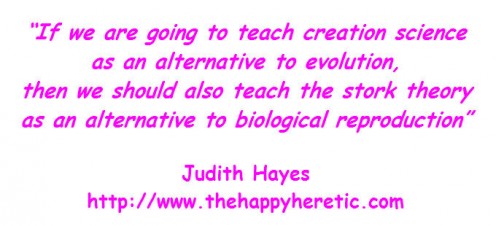
What is the Theory of Evolution?
The theory of evolution is one which indicates that life is constantly changing ~ adapting to its environment, so that only those organisms most suited will ultimately survive ~ ie. 'Survival of the most fitting / the fittest'.
The means of change include: selection (and re-combination), mutation and genetic drift.
This ongoing 'adaptation' has continued to occur (perhaps on and off) over hundreds and thousands and millions of years, to the extent that simple, single cell creatures have evolved into modern creatures ~ including humans.
The 'Theory' is controversial. One of the most controversial aspects of the theory ~ to Creationists, that is ~ is that humans are closely related to chimpanzees and that, like chimpanzees, they are descended from ape-like creatures. Creationists argue that the Bible assures us that God created all creatures, within six days, including 'man in his own image'
Be that as it may, most scientists accept evolution as true.
The implication is that change is incredibly slow. However, some scientists have suggested that there might be lengthy times when little of note happens ~ 'stasis' ~ followed by flurries of evolutionary activity.
Long-term, the results would be much the same ~ major change over a long period ~ but, within that long period, there may be very little change for very long periods of time, and then a big change in a short period of time.
Stephen Jay Gould was a proponent of this alternative view.
Some Books on Evolution
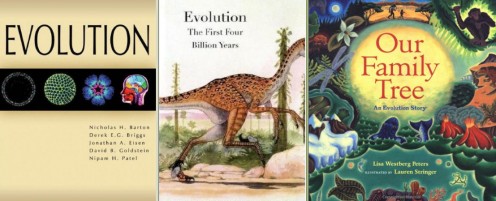
Stephen Jay Gould and 'Punctuated Equilibrium'
Stephen Jay Gould (1941 – 2002), Harvard teacher, palaeontologist, and historian, was a well-known and influential evolutionary biologist.
He developed, with Niles Eldredge, an evolutionary theory that they called ‘punctuated equilibrium’. They believed that there were long periods of ‘evolutionary stability’, or ‘stasis’, interspersed with shorter periods of rapid evolutionary change.
Although he criticised some Darwinian evolutionary views, Gould definitely believed that evolution had occurred and he wrote against ‘creationism’ and ‘intelligent design’.
However, the ‘New World Encyclopedia states this:
'In presenting the theory of punctuated equilibria, Niles Eldridge and Gould noted:
~ "Most species, during their geological history, either do not change in any appreciable way, or else they fluctuate mildly in morphology, with no apparent direction." ~
'Once a species appears, the fossil record does not change much during its existence, which may be several million years. This view accords well with the view of creationism, which references a clear-cut boundary between species, as well as stability during their existence.’
http://www.newworldencyclopedia.org/entry/Gould,_Stephen_Jay
The Genetical Theory of Natural Selection by Ronald Aylmer Fisher

Natural Selection
What is (Natural) Selection? (And Re-Combination)
Let us look at the giraffe.
This is what I was told as a child. It may not be (completely) correct, but it does still explain how natural selection might work:
Giraffes eat the leaves of the acacia tree and acacia trees are tall.
Imagine that, once upon a time, there were tall acacia trees and smaller ones. Any giraffe, of whatever height ~ with whatever length of neck ~ could then enjoy eating acacia leaves from any of the trees.
But what if something happened, and all acacia trees started to become taller, so that there were no little ones left? The shorter giraffes ~ ie those with shorter necks ~ would not be able to eat. They would starve to death.
Those small giraffes would have carried alleles (genes) for short necks. If they died before reproducing, then their short-neck alleles would have died with them. Over time, they would die out completely (or become very rare).
Long-neck giraffes would have to mate with long-neck giraffes, because the short-neck ones would have died out, or become so rare. Long-neck giraffes would, in turn, be likely to give birth to babies with long necks. If, by any chance, a child inherited the short-neck allele, it could not survive past weaning, so it would die out.
The traits would, in effect, have been 'selected' and 're-combined'.
'Nature', as it were, would have 'selected' the long-neck giraffes to survive and would have 'selected' the short-neck giraffes to become extinct.
This is an imaginary scenario, but it gives an example of how 'natural selection' might happen.
Darwin's Finches + Peacock's Tail - Natural Selection in Action
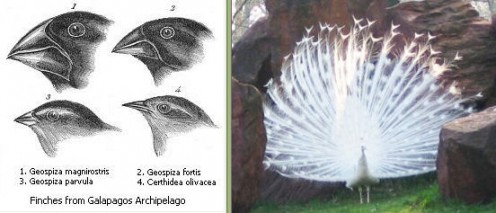
Evolution? Creation?
What is Mutation?
One of the known evolutionary mechanisms is ‘mutation’. A mutation is a random change in genetic material, which leads to new traits in an organism. It is not originally inherited genetically ~ but can be passed on, genetically, if it is the type of mutation that occurs in the reproductive cells.
Steve Jones writes: 'mutation is the fuel rather than the engine of biological advance.'
Other quotes from Jones:
'.. males .. are responsible for most mutations'.
'The chance of error increases each time a cell divides.'
'Evolution is inevitable. It depends on mistakes in reproduction. Descent always involves modification, because any copy, be it of a picture or a gene, must be less than exact. Information cannot be transmitted without loss, and a duplicate of a copy is, in its turn, less perfect than what went before.' [Almost Like A Whale]
*
I read that mutations are always harmful ~~ and often they are ~ but always??
I needed to check this out.
Actually, it seems that mutations may be either harmful or beneficial, depending on the individual and its environment, so should, perhaps, be considered neutral.
Can I find some ‘good’ mutations?
What about in pandas?
A beneficial mutation in the Giant Panda is his ‘thumb’. This extra ‘digit’ helps him to harvest and eat his food ~ bamboo. It is not really a thumb ~ it is a mutated wrist bone.
And in humans?
I needed a definite beneficial mutation in humans (cleft chins ~ dimples ~ being attractive to some women didn’t really count as a serious benefit!) and I found this: ‘In Humans, the CCR5 gene location is on the short (p) arm at position 21 on chromosome 3. Certain populations have inherited the Delta 32 mutation resulting in the genetic deletion of a portion of the CCR5 gene. Homozygous carriers of this mutation are resistant to M-tropic strains of HIV-1 infection.’ That has got to be a beneficial mutation! [http://en.wikipedia.org/wiki/CCR5 ]
And then there is the sickle cell anaemia enigma ~ is it harmful or beneficial?
‘Sickle-cell anemia is one of hundreds of life-threatening disorders that are known to be caused by a change in just one of those 3 billion A's, T's, C's, or G's. Because so many diseases are associated with mutations, it is common for mutations to have a negative ...... In addition, some mutations are actually beneficial. For example, the very same mutation that causes sickle-cell anemia in affected individuals .... can confer a survival advantage to unaffected ... when these people are challenged with the malaria pathogen. As a result, the sickle-cell mutation persists in populations where malaria is endemic.’
[http://www.nature.com/scitable/topicpage/genetic-mutation-441 ]
Mutation Chart and Floral Example
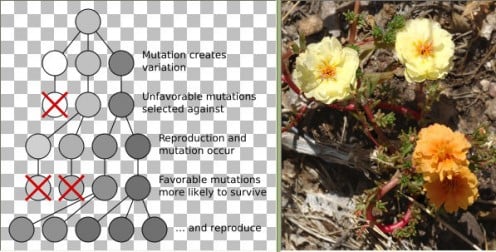
Apes, Etc
Genetic Drift
Genetic Drift Definition from Wikipedia:
'Genetic drift or allelic drift is the change in the frequency of a gene variant (allele) in a population due to random sampling. The alleles in the offspring are a sample of those in the parents, and chance has a role in determining whether a given individual survives and reproduces.'
[Futuyma, Douglas (1998). Evolutionary Biology.]
*
I am not sure that I have fully understood the meaning of genetic drift, but I have read that it occurs in smaller populations and I can imagine the following scenarios taking place:
Let us imagine that a child is being conceived. He will inherit one trait from his mother and one from his father ~ one allele (gene) from each, per trait (to keep it simple).
Let us consider eye colour.
The new baby's parents will carry eye-colour alleles that they have inherited, in turn, from their own parents.
Let us say that, at the locus in question, both parents carry a recessive allele for blue eyes and a dominant allele for brown eyes. (Maybe they each had a blue-eyed mother and a brown-eyed father??)
Brown eyes, being dominant, are indicated by a capital 'B'.
Blue eyes, being recessive, are indicated by a lower-case 'b'.
The baby's mother carries these alleles: B + b
The baby's father also carries these alleles: B + b
Since brown is dominant, they both have brown eyes, but, since each carries a 'hidden' recessive allele for blue eyes, they still have the ability to pass that trait on to their offspring.
The new baby will inherit one allele from this 'eye colour' gene pair from its mother and another one from its father.
The rules of mathematical probability indicate that these alleles are likely to be shuffled thus:
B from father + B from mother = BB -> brown eyes (because of two dominant brown alleles)
B from father + b from mother = Bb -> brown eyes (because of one dominant brown allele ~ but a recessive blue is also carried)
B from mother + b from father = Bb -> brown eyes (because of one dominant brown allele ~ but a recessive blue is also carried)
b from father + b from mother = bb -> blue eyes (because of two recessive blue alleles)
Probability indicates that he is likely to have brown eyes. As we have noted, he has a 3 in 4 (75%) chance of that happening.
He has a 2 in 4 (50%) chance of having brown eyes, but in inheriting the blue allele as a recessive.
He only has a 1 in 4 (25%) chance, of having blues eyes.
And, in a large group of people, the laws of probability will, probably, ensure that this is the general pattern throughout the population.
However, this may not be the case in a small group of people. The laws of probability still hold true, but they may not show themselves so easily in a small group.
To illustrate this phenomenon, imagine tossing a coin to decide on heads or tails. There is a 50% chance of getting heads and a 50% chance of getting tails. If you flick the coin 100 times, you should get about 50 heads and about 50 tails. If you flick the coin 50 times, you should get about 25 heads and about 25 tails. And so on.
But it would not be impossible, would it, to get 3, 4, 5 or even 6 'heads' in a row? The overall pattern would still be 50/50, heads and tails, in accordance with the mathematical laws of probability, but there may still be random, chance, brief runs of one or the other.
Similarly, a couple who carries both brown and blue eye colour alleles, instead of having a brown-eyed child, a blue-eyed child and two brown-eyed children who carry the blue recessive allele, might, by random chance, only have children with blue eyes.
Alternatively, they might have several children, with all of the different available combinations of eye colour, but all might die, except the one with only blue eye-colour alleles.
Or they might, again, have several children, with all of the typical spread of eye colour alleles, but those children may never reproduce. There are various random possibilities.
In a large population, these unusual occurrences might just be lost in the larger group, and the overall eye-colour possibilities would still occur in more-or-less the correct, expected ratios.
In a small population, the results could be very different.
This couple, if they had 4 children, could have been expected, according to probability laws, to give birth to 3 brown-eyed children and one blue-eyed child. But what if they actually gave birth to four blue-eyed children?!
Imagine if other couples in their little tribe also had more children than expected with blue eyes? ~ Or, what about if their brown-eyed children happened to die?
Random chance may lead to deliberate selection:
What if blue eyes, being ~ generally ~ more unusual, were considered particularly attractive, or special, or lucky, and blue eyed people became more likely to mate and have children of their own?
Or, what if blue-eyed people ~ for whatever reason ~ started to mate only with blue-eyed people?
The result, in a small population, could be that blue eyes ~ the recessive colour ~ could, unexpectedly, become the most common colour in the group.
Diagrammatic Example of Genetic Drift
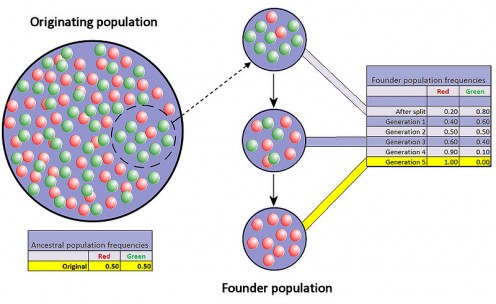
Evolution in Action: Snake and Newt
The common garter snake is the natural predator of the rough-skinned newt. According to Wikipedia, 'an evolutionary arms race' is going on between the two, as the newt produces a protective tetrodotoxin, while the snake produces an effective tetrodotoxin resistance.
The result is that very high levels of both toxin and resistance are found in this 'predator-prey pair'. 'Matched sets of adaptations' have occurred.
http://en.wikipedia.org/wiki/Evolution
Rough-Skinned Newt and Garter Snake
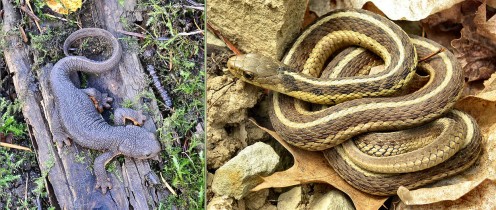
A World To Fit Us or Us To Fit A World? (Survival of the Fittest)
Certain traits die out, because they are not beneficial in certain circumstances. Other traits survive, and thrive, because they particularly suit the circumstances. That is the survival of the most suitable, or most fitting, traits ~ alternatively called 'survival of the fittest'.
It was philosopher Herbert Spencer who first coined the term 'survival of the fittest'.
In his 1864 work, 'Principles of Biology', he wrote: “This survival of the fittest ... is that which Mr. Darwin has called 'natural selection'..."
Darwin borrowed the phrase for the fifth edition of his 'On The Origin of Species', published in 1869. (The first edition was published in 1859)
The meaning of this phrase is often misunderstood. Darwin intended it to mean: "better adapted for immediate, local environment" ~ ie most suited, or best fitted, for a situation.
*
The Bible implies that the world was created by God, and that mankind was then especially created to fit perfectly into that world. Evolution would say that man has evolved to fit into his world and that any being that did not fit simply would not ~ could not ~ exist. The world appears to be made for us, but, actually, we have evolved, by natural selection, so that we fit into the world.
The Evolution of Man?
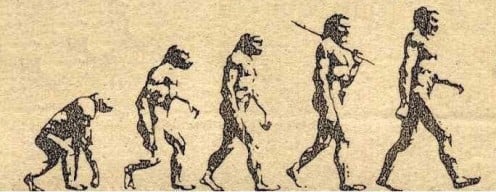
Modern Humans - Homo Sapiens
The Bible (Genesis) indicates that humans ~ interpreted as modern Homo sapiens ~ were created by God.
The theory of evolution indicates that modern man ~ Homo sapiens ~ evolved, in Africa, from earlier, types of human.
Unless we interpret Genesis as symbolic, then the two ideas contradict each other.
Anthropological and other research confirms that modern humans developed in Africa, thousands of years ago (a group of them then left the continent and, eventually, populated the whole world).
Dr Alice Roberts writes: 'Modern humans sprang from the African population, some around 200,000 years ago...' ['The Incredible Human Journey]
The people termed 'Mitochondrial Eve' and 'the African Adam' belonged to this population.
Mitichondrial Eve and the African Homeland
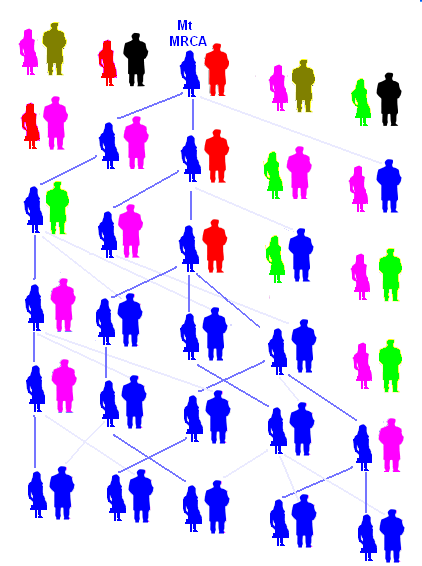
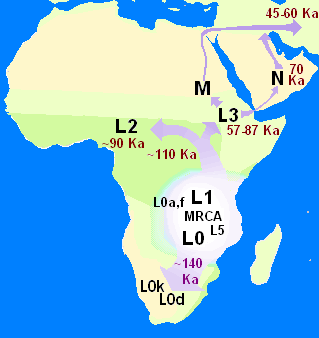
Two Eves - Mitochondrial and Mythological / Biblical, Plus Two Adams
Everyone in the world today descends from one African woman, who has been labelled 'Mitochondrial Eve'.
The mitochondrial DNA of us all can all be traced back to this mystery lady. Mitochondrial DNA is inherited via the mother, so this is a case of going back through the mother's DNA, generation by generation.
Mitochondria are inherited from mother to child. A female inherits hers from her mother, and from her maternal grandmother, and from her maternal great grandmother, etc, etc. Females then pass them on to their own children. Sons inherit them, but do not pass them on.
But 'Eve' is something of a misnomer. It implies that she was somehow equivalent to the Eve of the Bible. And in some ways she was ~ an ancient shared human ancestor from very early times.
But 'Mitochondrial Eve' was not the very first human woman. She is not even our only ancestor from the time. And this, our great, great, great, .... .... great grandmother, had parents and grandparents of her own. Our genetic treasure hunt ends with her, but not our ancestry. It is just that the traits from her parents and grandparents, from her friends, relatives, etc, have, as far as current research shows, been bred out over thousands of years.
'Mitochondrial Eve' is not 'Biblical Eve'.
Researchers have also been able to trace our ancestry back to just one man ~ African Adam. Males can trace their ancestry ~ just through the male line ~ via their 'Y' chromosomes. This has led to 'African Adam'. Again, this 'Adam' was not the very first human man, and he wasn't our only ancestor from his time. He just happens to be the one who shares DNA still contained in humans today.
He was not the 'Adam' of the Bible, and he was not Mitochondrial Eve's husband, or partner. He did not even live at the same time as her.
These two ancient humans do not vindicate the Bible ~ Scientists have not discovered the Biblical Adam and Eve.

STOP PRESS - OUT OF AFRICA
‘Thanks to climatic shifts, early modern humans might have crossed a shallow sea from Africa to a verdant Arabian Peninsula more than 125,000 years ago’
This was ‘about 75,000 years after Homo sapiens are thought to have evolved and tens of thousands of years earlier than they were thought to have left the African continent’.
Researchers decided this after finding ‘a trove of Paleolithic stone tools’.
Article by Katherine Harmon ~ January 27, 2011
http://www.scientificamerican.com/article.cfm?id=middle-eastern-stone-age-tools&WT.mc_id=SA_CAT_EVO_20110131
EDIT: 12th Feb. 2011
Adam and Eve and Confusion
Apparently, there is some confusion as to why African ‘Adam’ and ‘Eve’ are not Biblical ‘Adam and Eve’, and how they could, indeed, have lived at different times, yet still both be our ancestors.
If you look at the ‘comments’ section, you will see this:
Reader Comment: 'You wrote: "All humans can all trace our ancestry back to one African woman and one African man ~ they have been labelled 'Adam and Eve', but they are not the Biblical couple."
'Why not? You and nearly everybody else admits the human race can be traced back to two ancestors—and no further—who had to have been male and female in order to make a human baby. Can you mate with a chimpanzee? Of course not. Your only beef is calling them Adam and Eve. You say "this is where our treasure hunt ends" and then you say "they didn't live at the same time." That is impossible.'
+ _ + _ + _
I am not suggesting that our ancestors, who have been labelled ‘Y-Adam’ and ‘Mitochondrial Eve’, were chimpanzees. In fact, to the best of my knowledge, these were ‘modern humans’ just like us. In that respect, they are a bit like the legendary Adam and Eve of the Bible.
I am most certainly not suggesting that they mated with apes!
However, I repeat that they were not the first human beings; they were not the only human beings alive at the time; they were not ‘a couple’ and they were not alive at the same time as each other. This is not impossible.
I thought that my earlier notes had explained this, but I have to apologise, because they obviously did not make the explanation clear enough. Accordingly, I shall now include an explanatory ‘Family history’ analogy, or example ~ I hope that this will help to clarify matters:
* “ * “ * “ * “ *
Think of a line in your maternal ancestry;
Assume that you know who your great, great, great, great, great grandfather was, but that you then hit a brick wall with his line, and can get no further back.
And say that you know who your great, great, great grandmother was, but then you hit a brick wall with her line.
You can find no further records, beyond those that you already have.
You have found the earliest female ancestor that you possibly can.
And you have found the earliest male ancestor that you possibly can.
However, these people did, of course, have ancestors of their own ~ even though you cannot find records of them.
And these two ancestors were not married, and did not live at the same time, even though they were the earliest ones that you could find.
Is that any clearer?? :(
Science and God
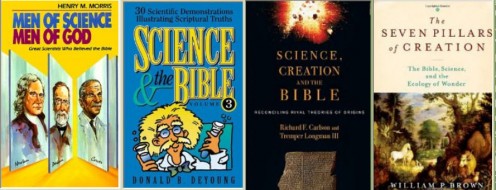
Science Proves The Bible?
Geneticists, anthropologists, palaeontologists and archaeologists, etc, have discovered Mitochondrial 'Eve' and genetic / African 'Adam'.
They have shown that all humans descended from those two people and that they were situated in one place on the Earth. Then they left that place they went and multiplied throughout the Earth.
Is this proof of Adam and Eve, and the Garden of Eden and God's command to go forth and multiply?
No, it isn't.
As previously stated, these two beings are not the Biblical 'Adam and Eve'.
'Watchtower' Believes Bible is Scientifically Accurate
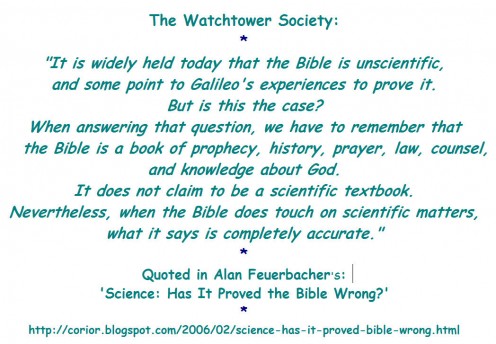
Science and the Bible
Bible + Science: Differing Views from Staff at a U.S. University
'Doesn't the Theory of Evolution Prove that the Bible is Wrong?'
"When I first became a Christian, I assumed that the correct answer was that the Bible is not a science book, and that the first chapters of the Book of Genesis should be understood in a figurative or poetical sense ....
But I was challenged .. to look at the scientific evidence for the Theory of Evolution before making up my mind ... having done so, I find that fewer inconsistencies arise if I interpret the first chapters of Genesis as narrative, not poetry.
This means that the Theory of Evolution, as a theory of the origin of life or of the origin of the species, is wrong.
I want to present a brief outline of the thinking that led me to this conclusion."
Jeff Harwell ~ Professor/Director Chemical Engineering
Read on here:
http://www.ou.edu/faculty/organizations/ouchrfas/evolhar.htm
(Oklahoma University ~ http://www.ou.edu/content/coe/cbme/audience/People/faculty1/harwell.html)
*
As a counter to this:
The University of Oklahoma is hosting 'Evolution 2011'
[ http://www.evolution2011.ou.edu ]
And this is an excerpt from:
'The OU Department of Zoology Statement on Evolution ~ Passed by unanimous vote':
'In science, not all explanations are equal. By the rigorous criteria of science, supernatural mechanisms, including Intelligent Design creationism, offer no scientific alternative to evolution
because they do not generate testable predictions about how species change or diversify. To argue that supernatural explanations merit discussion in science classrooms so that 'both sides' of the issue are taught is to advocate that non-science be legitimized as science.
In an era where scientific solutions to complex problems are of first priority, this is dangerous logic.'
And this is from their 'Zoology' front page:
'Evolution is a fact. Evolutionary theory is a cornestone of Biology'
http://zoology.ou.edu/
See also: http://www.biosurvey.ou.edu/dna/Sonleit_Diss.pdf
Africa - Human Homeland

'Out of Africa' Journey, Etc.
The First Humans (???) - What is a Human?
We humans belong to the genus 'Homo'. We are Homo sapiens. 'Sapiens' indicates wisdom, or knowledge.
The birth-place of mankind was Africa. All humans can all trace our ancestry back to one African woman and one African man ~ they have been labelled 'Adam and Eve', but they are not the Biblical couple.
We cannot trace our ancestors any further back, because of lack of genetic evidence, but they existed, living for thousands of years in Africa.
Some people think that we are so special, being made by God in his own image, that we shouldn't even consider that we might have ancestors who were not Homo sapiens. But we know that earlier humans existed.
We also know that, though there are obvious similarities, our DNA is different enough for us to have changed substantially from Homo ergastor.
But what about even earlier hominids?
The further we go back, very slowly, in time, with 'micro-evolution' going on at all stages, we are going to arrive at human ancestors, who are ever more different from us ~ until, eventually, these ancestors will start to look like ape-men.
If we go back, still further, then, eventually, we will arrive at creatures that can only be described as apes ~ not the apes living today, but their ancestors ~ and ours!
Micro-evolution, given long enough, will result in macro-evolution.
There is absolutely no doubt that plants and animals can change as a result of selection. Deliberate selection ~ breeding for certain traits by humans ~ illustrates the sort of thing that can ~ and does ~ happen in nature. It is artificially speedy.
Natural selection is slower ~ but it still happens. Slowly but surely it results in change; over thousands and millions of years, tiny changes can make enormous differences.
The Leakey family and their colleagues, for example, working in East Africa, the cradle of humanity, have found many, many fossils, which provide evidence for a variety of human ancestors.
Dr Alice Roberts writes: 'Chris Stringer, palaeoanthropologist at the Natural History Museum in London, has recognised four species during and since the Pleistocene (in the last 1.8 million years): Homo erectus, Homo heidelbergensis (the putative common ancestor of modern humans and Neanderthals), Homo sapiens and Homo neanderthalensis, although the recent discovery of the tiny 'hobbit' skeletons in Indonesia requires us to make room for Homo floresiensis as well.' [The Incredible Human Journey]
And Homo erectus had ancestors, too, of course!!
PrimateFeet
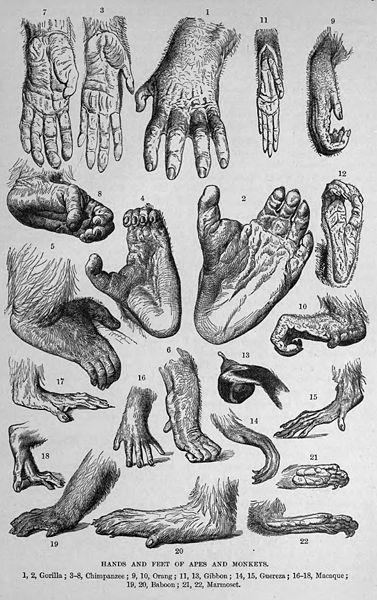
Homo, Hominid, Primates, Etc
Primates form a biological order, which includes a long list* of mammals, including prosimians (eg. lemurs, lorises, galagos and tarsiers) and simians (monkeys and apes).
Humans are primates.
The Hominidae (Hominids), or Great Apes, form a 'family' within the primates. The four living genera in this family are: chimpanzees, gorillas, humans (Homo sapiens), and orangutans.
~
According to ‘The Primate Family Tree’ by Ian Redmond, there are six characteristics associate with most primates. These are:
1. Eyes which face forwards
2. Protective eye sockets
3. Hands with one digit which grips the others to give grasping hands
4. Finger and toe nails
5. Fingerprints
6. Large cerebral hemisphere containing large brain
~
The long list*:
http://en.wikipedia.org/wiki/List_of_placental_mammals_in_Order_Primates
There is a time-line of human evolution here:
http://en.wikipedia.org/wiki/Timeline_of_human_evolution
Australopithecus Afarensis - 'Lucy'
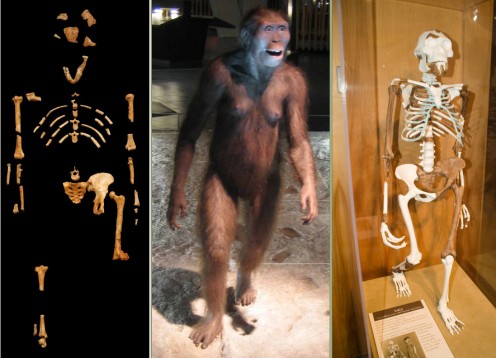
Lucy in the Sky with Diamonds
Famous early hominin, Australopithecus afarensis. 'Lucy', lived over three million years ago and her bones were discovered in 1974 in Ethiopia.
Much of her skeleton has been found and experts have deduced that she both walked upright on land and climbed easily in the trees.
Believed human ancestor 'afarensis' was not the only member of 'Australopithecus'. Others were: Australopithecus anamensis, A. sediba, and A. africanus. These were considered 'gracile'. Other more 'robust' examples may or may not be called Australopithecus. The alternative name for these others is Paranthropus.
The name, itself, is (first) part Latin and (second) part Greek. 'Australis' indicates 'southern' while 'pithekos' means 'ape'.
More info:
Laetoli Prints Photographic Poster Print
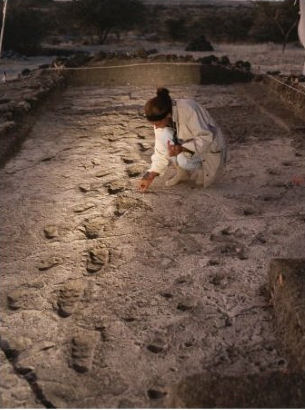
Laetoli Footprints
One of the most amazing and beautiful finds, relating to ancient man, is the set of footprints at Laetoli.
These footprints were found at Laetoli, in 1976, by Mary Leakey's team and they are 3.6 million years old. They may belong to Australopithecus afarensis people, or possibly another ~ maybe earlier ~ couple of individuals.
According to the website of the 'evolution Library', they were 'fomed and preserved by a chance combination of events -- a volcanic eruption, a rainstorm, and another ashfall.' They are particularly important because they provide early evidence of upright walking.
There is also a video.
Laetoli is in Tanzania about 45 kilometers south of Olduvai Gorge.
http://www.pbs.org/wgbh/evolution/library/07/1/l_071_03.html
See also:
Laetoli Footprints
'Flores Man' - By Desmond Morris
'The discovery of a new species of human [Homo floresiensis] poses exciting questions about who we are'.
'The truth .. is that there still remains a huge gap in our knowledge of what happened between the time of our remote ancestors and our more recent ones.
'But the new discovery of a tiny .., flat-faced, bipedal "ape-man" on the Indonesian island of Flores is rather different .... these hunters existed as recently as 12,000 years ago ....
'His very existence .. would make us question ... what it is to be human. We are not used to this because our ancestors successfully killed off all our close relatives.
'This has created a chasm between us and the other animals, a chasm so big that religion went as far as to say that we are not even related to them. ....
'Darwin put a stop to this nonsense with his theory of evolution, but amazingly the blindingly obvious truth he discovered is still resisted by large sections of the human population.'
By Desmond Morris ~ Author and anthropologist
Flores Man and his Cave

Turkana Boy and Others
Turkana Boy - Homo Ergastor
In 1984, at Nariokotome, near Lake Turkana (Great Rift Valley), in Kenya, Africa, Richard Leakey and his team were thrilled and amazed to discover the almost intact skeleton of a homo ergastor. It was that of a boy, aged about 11 (give or take up to about 4 years). This was a very exciting find. The child has been labelled the 'Turkana Boy'. He lived about one-and-a-half million years ago.
Homo ergastor had been discovered by Dutch anatomist, Eugene Dubois, in Indonesia, in the early 1890s ~ Java man. However, the specimen is very incomplete. Other items have been found in the area since then, but the quality is not very high, apparently.
'Turkana boy' has been classified as either / both Homo ergaster and Homo erectus.
Homo ergaster or Homo erectus?
This is what C. David Kreger has to say on the subject:
‘Homo ergaster is one of the more problematic of somewhat accepted species designations currently tossed around in anthropological literature. ... On the whole .. researchers see too little difference between ergaster and erectus to form the basis of a species of the former, separated from the latter.
'... recent analyses .. seem to indicate that even if ergaster specimens are considered as a different taxon than erectus, the erectus material is still closer to modern humans cladistically.
'.. H. ergaster does not show significant promise of lasting as a separate taxon due to several factors. It has not been shown to be significantly different from erectus to require the designation of a new hominid species .... At this time, ergaster basically means early H. erectus from Africa.’
[C. David Kreger:http://www.archaeologyinfo.com/homoergaster.htm]
*
Richard Leakey writes:
'Homo erectus, the Turkana boy's species, represented a pivotal point in human evolution. More or less everything that preceded Homo erectus was distinctly ape-like in important respects: in some of the anatomy, life history, and behavior. And everything that followed erectus was distinctly humanlike.
'The Turkana boy had been part of a major shift in human evolution, one in which the humanness we feel within us today were firmly planted. Homo erectus was at the forefront of a surge in brainsize, a boost in mental capacity.'
['Origins Reconsidered' by Richard Leakey and Roger Lewin, 1992]
Lake Turkana, Kenya, Africa
'Fairweather Eden'
Homo Heidelbergensis - 'Boxgrove Man'
Boxgrove, in West Sussex, is a ‘Middle Pleistocene’ archaeological site. The dig began in a quarry and the level at which the archaeologists found their ‘buried treasure’ was the ground level from half a million years ago.
‘Boxgrove’ is unusual, in that it is one of the very few places, where ‘pre-anatomically modern human remains‘ have been found in the British Isles ~ just a tibia in 1993 and some teeth in 1996, but these made headlines: ‘Europe’s Oldest man has been found in southern England’, rang out ‘The Times’. Whether or not this is ‘Europe’s oldest man’, I have no idea.
The male shin bone, that was found, was unexpectedly long and very robust, indicating a tall (over 1.8 metres), well-built individual. This early hominid has been labelled Homo heidelbergensis.
Heidelbergensis could be the ancestor of both ourselves ~ Homo sapiens ~ and our ‘cousins’, Homo neanderthalensis.
As well as early humans, boxgrove, with its supply of water, seems to have attracted various examples of wildlife, including horse, deer and even rhinoceros.
See:
http://matt.pope.users.btopenworld.com/boxgrove/boxhome.htm
http://matt.pope.users.btopenworld.com/boxgrove/sitehomo.htm
Other finds have been reported in the news. This is from ‘The Independent’, June 1994:
‘Not only have the archaeologists found the stone and bone tools themselves, but they have also discovered the sites where the Boxgrove People made them. At one place the toolmaking debris was preserved so well that one could actually see how the person was sitting when he made his flint tool half a million years ago’
http://www.independent.co.uk/arts-entertainment/archaeology-boxgrove-man-reveals-his-stone-ageold-secrets-1424281.html
You can read ‘A day in the life of Boxgrove Man, 480,000 years ago’, an article by Gareth Huw Davies, which was first published in the Radio Times, in January 1996.’
It is here: http://media.gn.apc.org/members/3/index6.html
There are some good photos of the area, here:
http://www.archaeology.co.uk/the-timeline-of-britain/boxgrove.htm
There is an article about Boxgrove on the site of The Biblical Creation Society :
http://www.biblicalcreation.org.uk/origins_archaeology/bcs063.html
I, personally, first encountered ‘Boxgrove Man’ in 1998, when I bought the very enjoyable book: ‘Fairweather Eden ~ Life in Britain half a million years ago as revealed by the excavations at Boxgrove’ by Michael Pitts and Mark Roberts.’
Monkeys - Not as Closely Related to Chimps as We are.
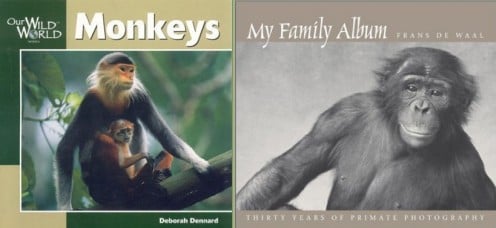
Paleoanthropology
Family Tree
The book 'Walking With Cavemen', produced to accompany the TV series of the same name, gives a genealogical chart for mankind.
It starts, as every genealogist should, with ourselves / the present ~ Homo sapiens ~ and works backwards.
One step back from Homo sapiens is Homo heidelbergensis.
Our 'cousins', Homo neanderthalensis (Neanderthal Man), are also descended from heidelbergensis.
A step back from Homo heidelbergensis takes us to Homo ergaster. Homo erectus, a 'cousin' of heidelbergensis, is also shown as being descended from ergastor.
Homo ergastor is descended from Homo habilis, but there may be other, intermediate, steps.
Homo habilis is ~ again with assumed intermediate species ~ descended from Australopithecus afarensis.
More information is included, but this is the relevant genealogy.
*
We have already noted that C.David Kreger considers that: '.. H. ergaster ..... has not been shown to be significantly different from erectus to require the designation of a new hominid species'.
'Those who see erectus as a modern human ancestor, either see the Asian specimens as a dead-end side branch, or see all the ergaster, heidelbergensis, and erectus specimens as belonging to Homo sapiens.'
I noted, above, that 'Homo ergastor is descended from Homo habilis ~ with some intermediate steps ~ but what does C.David Kreger say about this?
'The dates for erectus have become earlier and earlier, while habilis remains have been found in later and later deposits, making a lineage involving habilis ancestral to erectus increasingly unlikely. ...
Interesting!
More Information available from:
www.archaeologyinfo.com
Damascene Moment Quote - David Attenborough

Bonobo
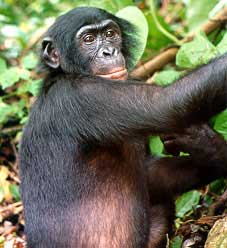
Chimps Are People Too?
There is a movement to accept that chimpanzees are so closely related to humans that they should be classed as humans.
Chimpanzees have been taught to speak English ~ using sign language and the 'Lexigram board'.
Chimps also seem to have their own language. In one documentary I saw, the presenter recognised a 'word' that different chimpanzees kept calling out. He wondered if it might be a a warning to him; realised that the 'word' was their sound for a 'big cat', and managed to escape in time!!!
'Are chimps cleverer than us?'
The content of this article is amazing ~ and thought-provoking!
'Researchers in Japan have pitted human adults against five-year-old chimpanzees in a test of mental agility and memory - and the chimps won.
'In a test of short-term memory involving numbers flashed on a computer screen, the apes comfortably beat their human opponents.
'This astonishing result, published in the journal Current Biology, shows that in at least some respects our position at the top of the intellectual tree may be a bit shakier than we thought.'
***
Chimps 'are people, too' ~ by Dick Taylor (BBC Horizon) 2006
‘In .. Iowa .. primatologist Sue Savage-Rumbaugh is conducting an experiment that has lasted 26 years. She's been rearing a small group of apes as if they are people, to see what happens. Her results appear to be spectacular ...’
http://news.bbc.co.uk/1/hi/sci/tech/6036281.stm
http://www.bbc.co.uk/sn/tvradio/programmes/horizon/broadband/tx/chimps/
'Court to decide if chimps are people, too' ~ by Jeanna Bryner (Live Science) May 2008
http://www.msnbc.msn.com/id/24878149/ns/technology_and_science-science/
Jane Goodall
"Chimpanzees have given me so much. The long hours spent with them in the forest have enriched my life beyond measure.
"What I have learned from them has shaped my understanding of human behavior, of our place in nature."
Zhang on Chimpanzee Evolution - University of Michegan News Service, Apr. 17, 2007
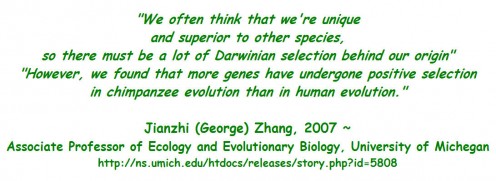
Gelada in the Moat - Besancon, France, 2010
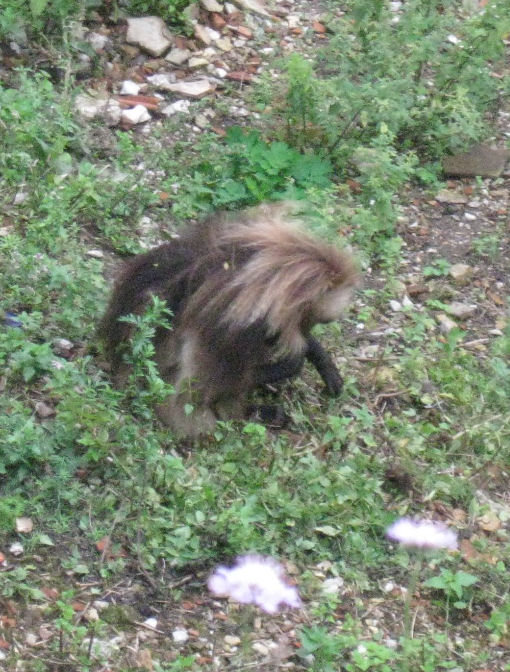
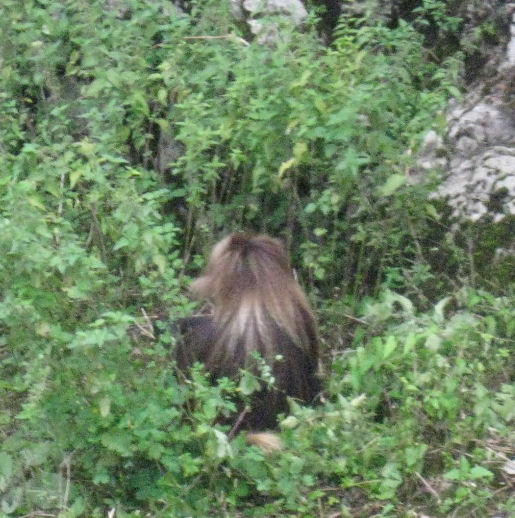
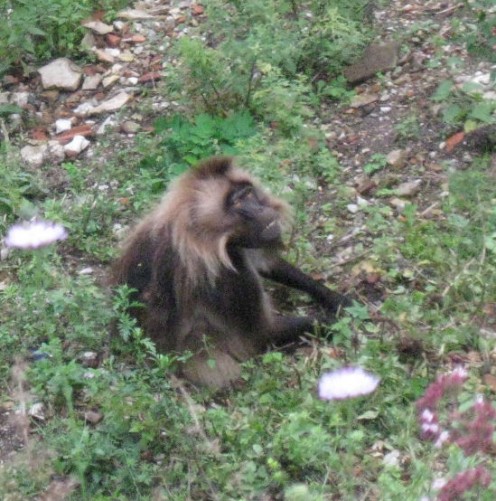
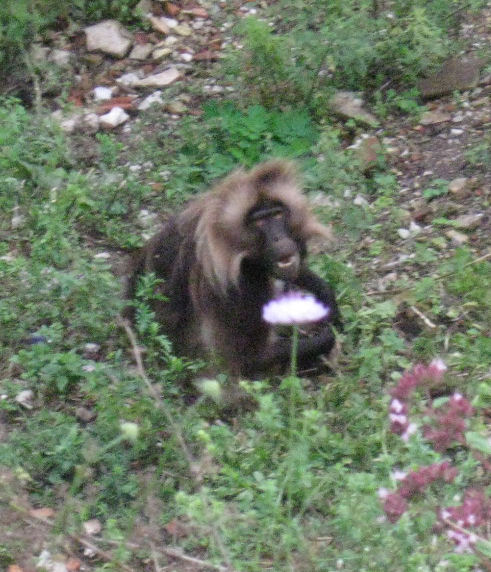
The 'Gelada' - a species of 'Old World Monkey'
*
In the early summer of 2010, I visited Besancon, in France, with my family. The beautiful historic citadelle doubles as a zoo.
We were all struck by some particular creatures, which were living in the grassy moat.
From the back, they looked like 'cavemen'. We couldn't take our eyes off them. It was like looking at our ancient ancestors.
When they turned to look at us, though, their features were baboon-like. I have since discovered that they are geladas ~ cousins of the baboon.
*
The 'gelada', or 'gelada baboon' ~ Theropithecus gelada ~ is from Ethiopia and is currently the only extant species within the theropithecus genus ~ it was thus classfied in 1979.
Gelada is related to the baboon (genus Papio), but scientists are in debate as to how close the relationship actually is.
Gelada is mainly a terrestrial creature of the grasslands ~ it is a peaceful grass-eater.
These particular geladas are being kept at Besancon, as part of a protection project, as the species is somewhat threatened in the wild. They arrived from Edinburgh in 2007.
*
It is interesting to consider how these animals are classified ~ compared, for example, to us, and to chimpanzees.
The chipanzee belongs, with us humans, to the Hominidae family, while
geladas, with their relatives the baboons, belong to the
Cercopithecidae family.
We are all primates but we humans are more closely related to chimps ~ but less so to geladas, baboons, etc.
However,
when we saw those creatures, that day, it was very obvious that they
were related to us.
And, if they are related to us, then chimps and bonobos are, indeed, extremely close relatives.
*
*
Gelada Classification
This is how gelada is classified:
Kingdom:Animalia->Phylum:Chordata->
Class:Mammalia->Order:Primates->
Family:Cercopithecidae->Sub-family:Cercopithecinae->
Tribe:Papionini->Genus:Theropithecus->Species:T. gelada
This is how the baboon is classified:
Kingdom:Animalia->
Phylum:Chordata-> Class:Mammalia-> Order:Primates->
Family:Cercopithecidae-> Genus:Papio-> Species:Papio papio (for
example - there are a few species)
Compare this to a chimpanzee:
Kingdom:Animalia->
Phylum:Chordata-> Class:Mammalia-> Order:Primates->
Family:Hominidae-> Subfamily:Homininae-> Tribe:Hominini->
Subtribe:Panina-> Genus:Pan-> Species:Pan troglodytes(Common
Chimpanzee)/ Pan paniscus(Bonobo)
And to a human:
Kingdom:Animalia->
Phylum:Chordata-> Class:Mammalia-> Order:Primates->
Family:Hominidae-> Genus:Homo-> Species:H. sapiens->
Subspecies:Homo sapiens sapiens
Male Gelada Baboon in Colchester Zoo + Male Guinea Baboon in Nuremberg Zoo
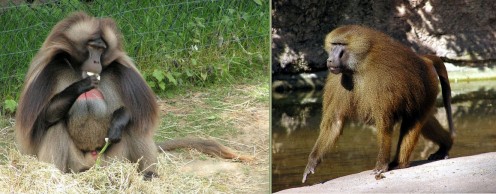
Common chimpanzee in the Leipzig Zoo and Bonobo at Cincinnati Zoo
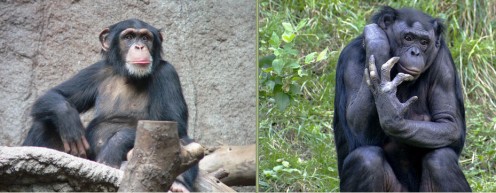
Micro and Macro Evolution??
‘Micro Evolution' ~ 'Macro Evolution'.
These two similar-sounding phrases seem to be of enormous importance to those who accept that dogs have evolved from wolves, but cannot believe that man has evolved from an ape-like creature ~ especially as the Bible states otherwise!
What do these words mean and are they really so very different?
'Micro Evolution'
'Micro Evolution' refers to changes within a species. Such changes might be those seen in domesticated dogs or cattle. Changes may be very noticeable, and the creatures may change a lot, but they are still dogs, or cattle. The changes are not highly significant. No new species is produced.
Oxford dictionary definition: ‘evolutionary change within a species or small group of organisms, especially over a short period'.
'Macro Evolution'
While 'Micro Evolution' concerns insignificant changes within a species, macro-evolution is, or would be, highly significant. Most creationists do not believe in Macro-evolution, because it would result in major changes and the birth of entirely new species from existing species.
Oxford dictionary definition: ‘major evolutionary change, especially with regard to the evolution of whole taxonomic groups over long periods of time’.
Oxford dictionary
[http://oxforddictionaries.com ]
*
Austin Cline (BA University of Pennsylvania; MA Princeton University), of 'About.Com': 'There is one particular aspect of evolution that needs to be given specific attention: the somewhat artificial distinction between what is called “microevolution” and “macroevolution”, two terms often used by creationists in their attempts to critique evolution and evolutionary theory.'
I agree with him, that this most certainly is a 'somewhat artificial distinction'. It seems to me that, what I see as micro-evolution in the short term could be seen as macro-evolution in the long term.
I have stated, before, that, to me, 'micro-evolution' and 'macro-evolution' are the same thing. Micro-evolution, given long enough, will result in macro-evolution. If a person believes in the one, then, to me, logically, they should believe in both.
The big hurdle seems to be largely one of semantics ~ the word 'species' and its definition, which is so vague that this term should not cause problems.
Creation Controversy
* *
‘Heart and Soul’ is a radio programme, from the BBC World Service, which looks at the effects that religion and belief can have on followers.
In a two-part edition, from February 2009 ~ ‘In The Beginning’ ~ they examined the differing, and indeed opposing, views of creationists and of those who accept evolution as true.
They specifically looked at the controversy in the USA, since a particularly high number of Americans are considered to believe in the Creation.
Apparently;
‘Most biologists in most respected universities support [Darwin’s] explanation and most agree that that process has taken hundreds of millions of years.’
However;
‘In a recent survey, more than 40% of Americans said they thought that humans and other creatures had been created in their present forms and have not evolved.
'Of those who did accept evolution, a third thought that it was guided by some supreme being.‘
That is quite an interesting phenomenon!
I have noticed that some very well educated scientists support the Creationist view. This actually intrigues me ~ and I would like to find out more, and to understand why those educated in the sciences still reject this view, which is held by most scientists.
I wonder why this is such a particularly American phenomenon ~ or, indeed, is it??
* *
'Adam'

Against Intelligent Design, Creationism, Etc
What Is 'Intelligent Design'?
'Intelligent design' ~ is this 'creationism' by another name?
I.D. has its own website, so I shall allow them to define their terminology:
"Intelligent design refers to a scientific research program as well as a community of scientists, philosophers and other scholars who seek evidence of design in nature.
'The theory of intelligent design holds that certain features of the universe and of living things are best explained by an intelligent cause, not an undirected process such as natural selection.
'Through the study and analysis of a system's components, a design theorist is able to determine whether various natural structures are the product of chance, natural law, intelligent design, or some combination thereof. "
http://www.intelligentdesign.org
Evolution and Christianity
Are Evolutionists Anti-Faith?
It is quite possible to be a Christian ~ or other Believer ~ who accepts the Theory of Evolution. Many Christians have many different beliefs, ideas and opinions.
Atheists do not have a monopoly on Evolution (also known as Darwinism).
Of course, there are many evolutionists, who are also atheists ~ and many atheists cannot understand how, or why, Believers actually ... believe.
They see the Bible as illogical, but science as logical. They do not think that Bible and Science can co-exist ~ and they question the Christian lack of logic.
BUT there are a number of scientists, who are also Christians.
Indeed, there are a number of evolutionists who are also Christian. The teacher at my school, who was an Anglican priest, accepted Evolutionary theory.
Apparently the Pope believes in Evolution!
There are several Anglican Bishops who believe in Evolution ~ so I doubt that these evolutionists are 'anti-faith'.
A few years ago, a joint letter was sent, by a number of academics and a number of Christian churchmen, to the then Prime Minister ~ Tony Blair. It concerned evolution and its teaching ~ or the lack of it ~ in certain schools. Here is an excerpt from that letter:
"Evolution is a scientific theory of great explanatory power, able to account for a wide range of phenomena in a number of disciplines. .... It is not ... a 'faith position in the same category as the biblical account of creation ..."
It was signed by the then Anglican bishops of Oxford, St. Albans, Hereford, Birmingham, Southwark, Portsmouth and the Roman Catholic bishop of Portsmouth.
In 2004, Lord Richard Harries, then Bishop of Oxford, joined Richard Dawkins in writing an article on evolution for the Sunday Times. One of his own, specific, contributions to the article, apparently, was this sentence:
'Evolution is a fact and, from a Christian perspective, one of the greatest of God's works'.
See Dawkins's article in The Times: http://entertainment.timesonline.co.uk/tol/arts_and_entertainment/books/book_extracts/article6805656.ece
Darwin's Religious Odyssey - Phipps
Darwin's Religious Odyssey
These quotes are from a 'Publishers Weekly' review, as seen on Amazon:
'Anti-evolutionary writers tend to depict Charles Darwin as a godless infidel who was bent on disproving biblical events and supplanting religion with a new god-science.
'But in Darwin's Religious Odyssey, philosophy professor William Phipps takes great pains to demonstrate that Darwin's religious worldview, well, evolved; he began as an orthodox Anglican priest-in-training and wound up as a self-tortured but not irreligious skeptic.'
Pope Benedict on Evolution and Creation

Is Evolution 'Just a Theory'? ~ What Is A Theory?
A 'theory' is an idea; a hypothesis; an unproven suggestion. It is just a mere theory. Isn't it?
No! It actually isn't.
There are informal uses of the word 'theory' to mean an unsubstantiated idea, or an unproven hypothesis ~ or even a fanciful speculation ~ but there is much more to a theory than that ~ especially a 'scientific' or 'mathematical' theory.
A 'Scientific Theory' is not just a hypothesis!
After all, there is very little controversy over "Gravitational Theory".
My copy of the Oxford English Dictionary gives a number of related, but different, definitions.
It acknowledges the fanciful speculation ~ eg 'the pet theory' and 'The sphere of abstract knowledge or speculative thought. Eg. This is all very well in theory, but ...'.
However, it also describes a 'system of ideas explaining something, especially one based on general principles independent of the facts' and gives 'atomic theory' and the 'theory of gravitation' as examples, as well as 'evolution'. It states that it is 'opposite to hypothesis'.
Two other definitions are the 'exposition of the principles of a science' such as 'the theory of music' and 'mathematical propositions to illustrate principles of a subject'. eg 'probability theory' and the 'theory of equations'.
This makes it clear, I think, that a theory may indeed, just be a matter of fanciful speculation, but that, in this situation, it is more likely to be a scientific or mathematical exposition of principles, based on observation, experience, experimentation, etc ~ ie, not based on guesswork, but on scientific knowledge!
It seems ironic, to me, that there are people, who seem to neither know, nor truly understand, the meaning of scientific theory, yet who feel qualified to mock said theory ~ and even competent to disprove it.
*
David Attenborough:
“People write to me that evolution is only a theory. Well, it is not a theory. Evolution is as solid a historical fact as you could conceive. ..... the historical reality that dinosaurs led to birds, and mammals produced whales, that's not theory"
"Evolution is a Fact" - Bishop
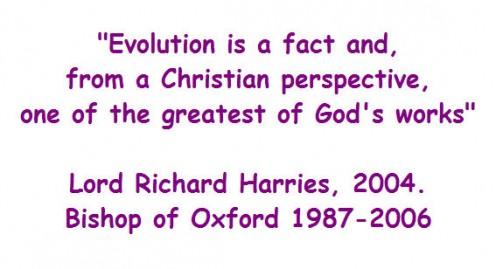
Creationism Etc.
Can Christianity and Other Faiths Co-Exist With Evolution, Or Is It Only For Atheists? ~ Is There No room for 'The Divine'?
As I have already mentioned, there is a letter which answers this question.
It is one which concerns 'evolution' and its place in the school curriculum. It was sent to Tony Blair, the then Prime Minister of the UK, and it was signed by a number of scientists AND a number of Christian bishops.
I would guess that the Pope and most Roman Catholic and Anglican Bishops and Archbishops believe in 'the divine' ~ yet a number of these clerics have publicly stated that they believe in evolution.
Christianity and other faiths can co-exist with evolution.
Evolution is not just for atheists.
There does seem to be room for 'The Divine'!
Evolution is not a religion.
Evolution is not a tenet of any 'Atheist Faith'.
Evolution does not encourage crime or hatred.
Any subject can be use and abused by any people to their own ends.
Prothero: 'Evolution is Not a Religion'
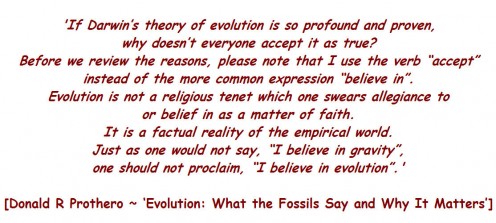
Has Anyone Ever Actually Seen Evidence of Evolution?
Evolution is a slow process ~ a very, very slow process.
However, we may still see evidence for it.
~ The fact that animals may be artificially bred to be different is evidence that this could, equally, happen in nature ~ but more slowly.
~ Fossil evidence indicates that creatures have evolved over time.
~ DNA evidence indicates that creatures have evolved over time.
~ Vestigial remains indicate that creatures have evolved over time. Human examples include the coccyx ~ the vestigial tail ~ and the appendix.
And what about this??!!
‘Researchers have found that the shape of the human skull has changed significantly over the past 650 years. Modern people possess less prominent features but higher foreheads than our medieval ancestors’.
[Rebecca Morelle, BBC News science reporter. Article: ‘Time changes modern human's face’, 25 January 2006, http://news.bbc.co.uk/1/hi/4643312.stm ]
Birmingham University School of Dentistry researchers compared skulls from deaths in the 14th and 16th centuries ~ 30 plague deaths and 54 Mary Rose drownings ~ with 31 of those recorded in their recent dental records.
They discovered that the older skulls had more prominent features than modern skulls and that their cranial vault was smaller ~ ie the distance from eyes to top of skull.
Birmingham University Director of Orthodontistry, Dr Peter Rock, told the BBC: “The astonishing finding is the increased cranial vault heights. ... The increase is very considerable. For example, the vault height of the plague skulls were 80mm, and the modern ones were 95mm - that's in the order of 20% bigger, which is really rather a lot”.
Apparently, Rock suggested that this increase could be ‘due to an increase in mental capacity over the ages’.
Skulls From the Sunken Mary Rose Aid Research

Is Evolution a Proven Scientific Fact?
As I said, I am not a scientist, I am a historian.
But both evolutionists and historians involve themselves in studying the human past. And, from the point of view of the historian, talking about 'facts' is rarely seen as helpful, because knowledge is not fixed. New discoveries are constantly being made and ideas reviewed.
I would say that the same is the case with the evolutionary scientist. Evolutionary theory presents what is considered to be a truth ~ but revisions will, most likely, continue to be made. Scientific research is a work in progress!
But there is much evidence for evolution ~ in the form of fossils, for example. But not only fossils! Genetics has been a very useful tool in this pursuit. DNA provides a huge amount of evidence for family lines and evolutionary ancestry.
A number of scientists state that evolution is fact.
Fossils
Those who do not accept evolution attempt to disprove it by saying that there is little or no fossil evidence, yet, in my reading, I have come across many assertions that there is plenty of fossil evidence.
Steve Jones has written about evidence which links whales ~ from their hyena-like past to the water leviathans they now are.
Richard Dawkins on fossils:
"The evidence for evolution would be entirely secure, even if not a single corpse had ever fossilized. It is a bonus that we do actually have rich seams of fossils to mine, and more are discovered every day. The fossil evidence for evolution in many major groups is wonderfully strong."
There are a number of books available on the subject.
Dawkins on Fossils

DNA Structure
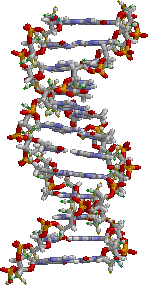
DNA and Living Fossils
In recent years researchers have found some amazing 'living fossils'.
Now, I wouldn't necessarily define us as fossils, but we are pretty amazing!
I would say that we are, ourselves, evidence of evolution.
It is written in our genes ~ recorded in our DNA.
And DNA, according to Sean Carroll, is the forensic evidence for evolution.
DNA - Evolution's Ultimate Forensic Record (S B Carroll)
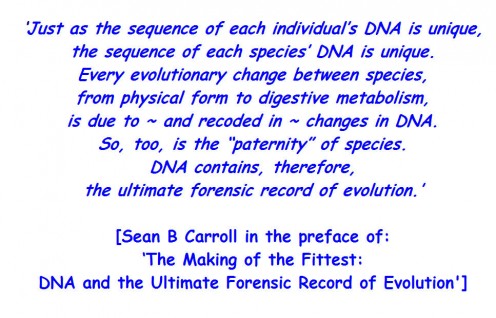
DNA Evidence for Evolution
How Important Are The Gaps in the Evidence for Evolution?
No-one knows everything. There will always be gaps in our knowledge.
However, when all of the available evidence points in the same direction, and all newly discovered evidence supports that existing evidence, then we have to assume that we are on the right track.
The relatively recent discoveries in the field of genetics support the theories that Darwin and Wallace put forward in the 1800s. That is very important.
Toy Poodle and Wild Wolf - Same Creature!
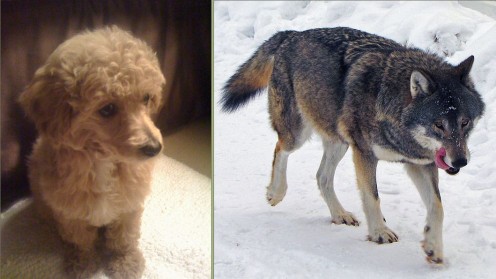
Wolf, Dogs and Fox
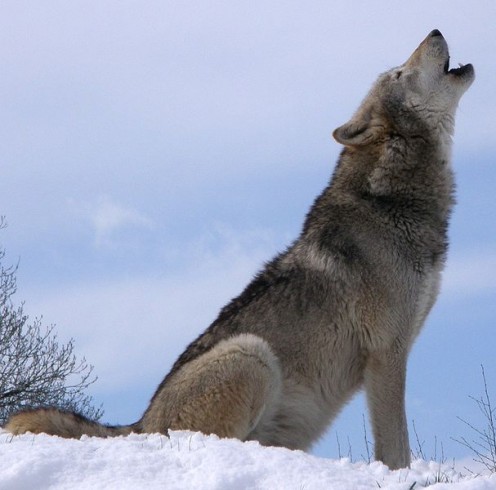
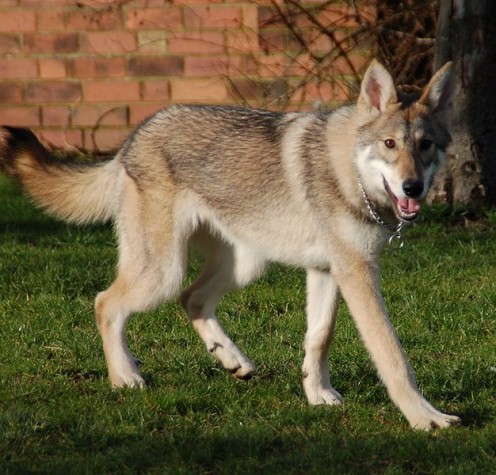

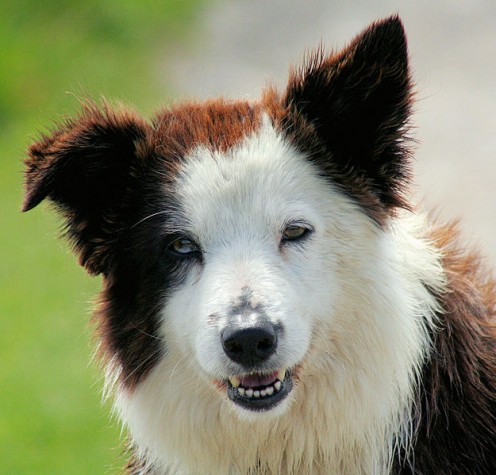

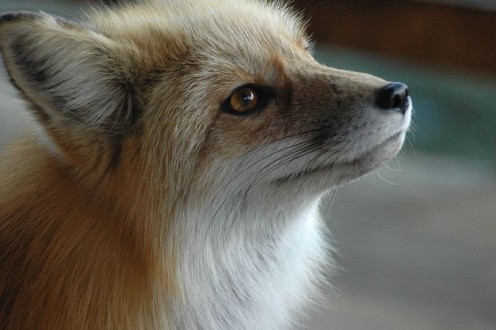
Man's Best Friend
The toy poodle is, basically, a wolf in disguise!
It would appear that, a few thousand years ago, man and his 'best friend' first became acquainted. For some reason, some wolves, instead of being scared off by human camp fires, were actually attracted to them. Perhaps it was because of the promise of meat bones and other food scraps.
A symbiotic relationship must have begun. Perhaps the ever-more-tame wolves helped humans to hunt better. Perhaps they protected them as they slept. Who knows? But something happened and man and dog / wolf have been close ever since.
DNA research proves that a dog is a domesticated wolf.
And since those first wolves became tame, man has been manipulating his companion ~ to hunt; to pull loads; to herd animals; to look cute and win dog shows ...
* * * * *
* * * * *
Interestingly, a team of geneticists has discovered that the type of coat a pure-bred dog has is determined by three genes. This was a 2009 'National Institutes of Health' (USA) research project.
Professor K. Gordon Lark, biologist of the University of Utah:
“We were part of a team that found three genes that control 90 percent of the seven coat types that characterize different breeds of purebred dogs"
The results showed that:
'All purebred dogs have the three genes, but the presence or absence of mutant, variant forms of those genes - rather than the ancestral forms inherited from wolves - determines coat type'.
Dogs have been bred to look very different from their wolf ancestors, whilst still sharing the bulk of their genetic DNA. If anyone believes that an animal cannot evolve, they need only look at a wolf and a toy poodle or chihuahua.
* * * * *
* * * * *
Steve Jones had some interesting information and observations to impart.
"Now the dog has disappeared, victim of evolution. ... Two centuries after it gained its scientific name, the International Commission on Zoological Nomenclature has stripped it of its identity. ... In 1993 the Smithsonian institution's Mammal Species of the world ... admitted the domestic dog only as a subspecies of the wolf Canis lupus."
* * * * *
* * * * *
It is interesting to discover that wild foxes, if they become more tame ~ having been 'selected' purely on their natural friendliness to humans ~ will 'evolve' to become more like dogs. Yet foxes are not as closely related to dogs as they look. (See section below.)
*
For a fictionalised view of the early taming of a wolf, etc, read the 'Clan of the Cave Bear' series, by Jean Auel.

Tame Foxes and Pet Wolves - or Dogs
Dimitri Belyaev, a Russian geneticist,and director of a Genetics institute in Siberia, decided on an experiment, in the 1950s, to breed wild foxes (Vulpes vulpes) for tameness. They were chosen according to how naturally tame they were.
He and his team (who continued the experiment after his death) made some extremely interesting discoveries.
The foxes chosen were those which opted to come nearer to humans and did not seem at all fearful of humans, etc. Otherwise they were just the same as any wild foxes.
But the newly selected foxes changed ~ and, over six generations, they changed in many ways. In many cases, their foxes' yelp changed to something more like a bark; the trailing brush tail now turned up, like a dog's tail; the typical fox brown coat actually changed to black and white; the upright ears became more floppy, like those of a dog. The females even came on heat 6-monthly, like in dogs, rather than 12-monthly, the norm for foxes. They wanted human attention ~ whimpering for it and licking hands, etc. As the generations went by, more foxes joined this ultra tame group.
The fox, just by being bred for observed tameness, changed.
Remember, these animals had not been tamed, they were simply the wild ones which seemed happier to be nearer to human beings.
It is possible that these changes mirror those that occurred in wolves, which became friendlier towards humans and which were, in turn, 'adopted' by humans.
Note: Although there is anecdotal evidence of foxes mating with dogs, scientists do not believe that it is possible, because they are too different, genetically.
They are different species. Dogs are the same species as wolves.
But would anyone deny, when looking at these creatures, that they are of the same family ~ and have the same ancestry!?
Britain's Agricultural Revolution - Selected Breeding
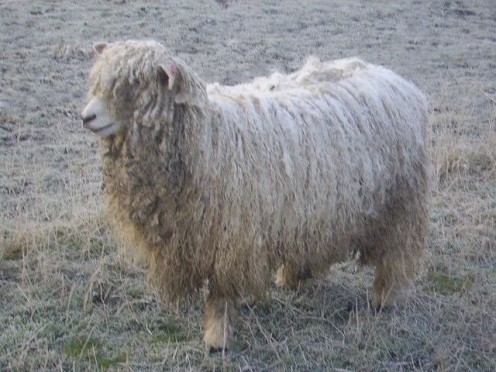
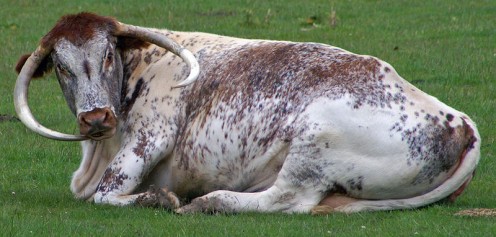
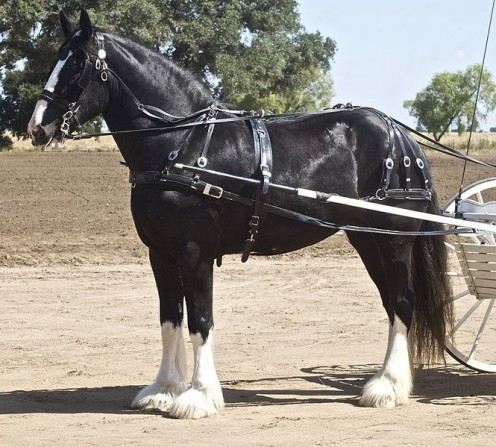
The Agrarian Revolution
In England, prior to the 'Industrial revolution', we had what has been termed an 'Agricultural Revolution'.
There is some controversy over the details, but it does seem that this was a period when selective breeding resulted in new 'improved' varieties of livestock and crops.
According to Wikipedia:
'Robert Bakewell and Thomas Coke introduced selective breeding (mating .. animals with particularly desirable characteristics), and inbreeding (mating of close relatives .. to stabilize certain qualities) in order to reduce genetic diversity ... from the mid 18th century. ...
'These methods proved successful in the production of larger and more profitable livestock.'
[ http://en.wikipedia.org/wiki/British_Agricultural_Revolution ]
Of Mice and Mice - and Men?
Steve Jones wrote this about certain mice:
"The centre of genetic diversity of the world's mice is in Pakistan and India. Mus musculus and Mus domesticus began their journey there, in a common homeland and with a shared pool of genes.
"Their ancestors travelled ... in separate waves north and south ... As they went, they evolved, until, at last, when the circle was closed and the mice met, each had changed enough to render them incompatible.
"As a result, each kind had been promoted to the status of a species rather than remaining as mere varieties of the same one."
Seeing is Believing - Sometimes
I have some first cousins, who look something like me ~ unsurprising, since we share grandparents and must have inherited some of the same traits. I also have some first cousins, who look nothing like me. We probably have inherited some of the same traits, but they are not obvious to the beholder. The answers would show up in our DNA, if it were checked.
But look at Helen Hunt and LeeLee Sobieski and Zooey Deschanel and and Katy Perry. They are very alike, yet, as far as I know, these two sets of women are not related.
Some people look alike because they share ancestors and others look alike, in spite of not being related at all. (Except very distantly, since all humans are related!)
It is the same with families of animals. Some look alike because they are related ~ they share recent ancestors ~ and some look alike through coincidence.
Let's look at bears:
Panda, Brown Bear, Polar Bear
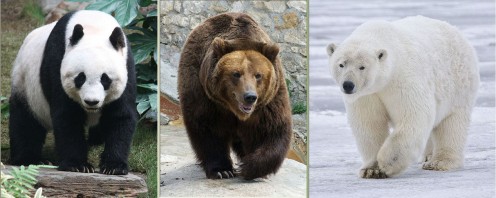
Let's Look at Bears
Where do bears fit into the classification of Earth's creatures?
They are animals ~ ie members of the animal Kingdom ~ Animalia; they belong to the Phylum Chordata; they are mammals ~ ie. they belong to the Class Mammalia; they are (generally) carnivores, so they belong to the Order Carnivora; they are considered to be dog-like, so they belong to the Suborder Caniformia; ....
(Pinnipeds also belong to the Suborder Caniformia ~ and Sun Bears can certainly resemble seals, I think!)
Bears are of the Family Ursidae (compare constellations Big and Little Bear ~ Ursa Major and Ursa Minor).
But there are different types of bear, so how does that fact fit into this classification model?
The division after 'Family' is 'Genus' (plural 'Genera') and there are currently three accepted genera of the Ursidae family: Ursus, Ailuropoda and Tremarctos.
The Genera:
~ The Ursus genus includes brown bears, polar bear and black bears
~ The Ailuropoda belongs to a sub-family of the Ursidae, known as the Ailuropodinae. It contains only one living species of bear ~ the Giant Panda (which lives mainly on bamboo).
(NB: The Red Panda ~ Ailurus fulgens ~ is not a bear (Ursid). It is the sole living member of its family: Ailuridae. It is of the genus Ailurus. It is further classified thus: Superfamily ~ Musteloidea; Infraorder Arctoidea; Suborder ~ Caniformia; order ~ Carnivora; Class ~ Mammalia; phylum ~ Chordata; Kingdom ~ animalia.)
~ The Tremarctos is a genus which belongs to a sub-family of the Ursidae ~ that is the Tremarctinae (which is also a sub-division of the Ursinae)
The division after 'Genus' is 'Species' (which can, again, be divided, into Sub-Species)
Some bears are already extinct, but there are currently eight types ~ ie. species ~ roaming different parts of the globe. They are:
1. Asiatic Black Bear ~ Ursus thibetanus, or Selenarctos thibetanus
2. North American Black Bear (or American Black Bear) ~ Ursus americanus
3. Brown Bear (Including North American 'grizzly') ~ Ursus arctos
4. Polar Bear ~ Ursus maritimus
5. Sloth Bear (or Labiated Bear) ~ Ursus ursinus or Melursus ursinus
6. Sun Bear (or Honey Bear) ~ Ursus (formerly: Helartcos) malayanus
7. Panda Bear (or Giant Panda) ~ Ailuropoda melanoleuca
8. Spectacled Bear (or Andean Bear) ~ Tremarctos ornatu
Within these Species, there are Sub-Species. For example, the Qinling panda (Ailuropoda melanoleuca qinlingensis) is a subspecies of the Giant Panda.
Bear Species Inter-Breeding?
Since these animals are all called 'bears', and they look alike, I would guess that people would automatically assume that they are all related ~ even if scientists hadn't already put them together in the same 'Family' ~ the Ursidae. However, to re-iterate, they may all be bears, but they are not all the same species of bear.
It is widely believed that members of different species generally cannot interbreed, but that, if they did, the offspring would either die young, or be born sterile.
The important questions are:
~ Have these different species of bears inter-bred to produce an 'Ursid Hybrid' cub?
~ If so, did any cub reach maturity?
~ If so, did any cubs go on to be parents?
Wikipedia gives a list of occasions; here are some of them:
~ Three cubs were born, when a black bear mated with a European brown bear, at London Zoo in 1859, but the babies did not reach maturity.'
~ Brown bears and polar bears have mated successfully a number of times, since 1874, in Halle, Germany.
~Three cubs were born after a Polar Bear got into the enclosure of a Kodiak Bear (type of brown bear) at the US National Zoo in 1936. They survived to breed together.
~ In 1970, there were four polar bear / brown bear hybrid bear cubs at the National Zoological Park in Washington.
~ In 1975, after a female Asian black bear shared her enclosure with a spectacled bear, at "Las Delicias" Zoo, Venezuela, she gave birth to a number of hybrids.
It would appear that pandas cannot breed with the other named species in this group ~ ie other bears ~ but that is not surprising, since the panda is not just a different species of the same genus, but is a member of a different genus ~ ie Ailuropoda rather than Ursus.
Species within the same genus are closely related.
Sun Bear - Does he look like a Seal? Or a Dog?
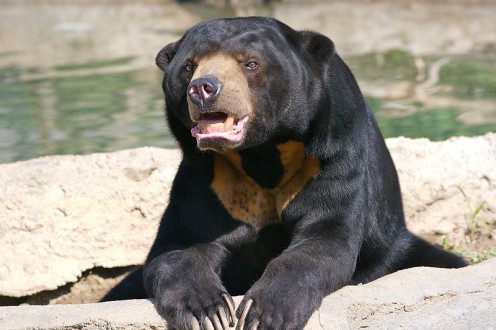
Classification of Animals
All animals are scientifically classified, according to where they belong in the family of life on Earth ~ but classifications are not carved in stone. If scientists discover new information, then the animal might be re-classified, or the classification name could be changed.
The main divisions are called taxonomical ranks (taxa). Animals are divided, and sub-divided, thus:
Domain ->kingdom ->phylum ->class ->order ->family ->genus ->species
There may be a sub-family, which may be divided, again, into tribe and, even, subtribe (or more than one of each). There may be a sub-genus ~ or more than one. There may be a sub-species ~ or more than one.
Whatever species may be ...

Species?
The New world Encyclopedia provides ‘just a few of more than a dozen common methods of delineating species among biologists’:
~ ‘Typological (or "morphological") species concept. ... collections of individuals that share a common phenotype, including morphology, behavior, and ecological relationships with their environment. ....
~ ‘Biological (or "isolation") species concept. ... as a set of actually or potentially interbreeding organisms.
~ ‘Mate-recognition species concept. ... a group of organisms that share a common fertilization system and are known to recognize one another as potential mates....
~ ‘Phylogenetic species concept. ...defines a species as a group of organisms bound by a unique ancestry.
~ ‘Evolutionary (or "Darwinian") species concept. An evolutionary species is a group of organisms that shares an ancestor...
~ ‘Ecological species concept defines a species as a group of organisms that share a distinct ecological niche. ...... ‘
http://www.newworldencyclopedia.org/entry/Species
*
Steve Jones:
'Whatever species may be ... they are not fixed. Instead their boundaries change before our eyes.'
The Species Problem - Jody Hey

'The Species Problem'
Darwin: "No one definition has satisfied all naturalists" and, in all the years since he was writing, little seems to have changed.
According to Wikipedia:
'Practically, biologists define species as populations of organisms that have a high level of genetic similarity.'
'.. any single, universal definition of "species" is necessarily arbitrary. Instead, biologists have proposed a range of definitions; which definition a biologists uses is a pragmatic choice, depending on the particularities of that biologist's research.'
More from Wikipedia:
'In biology, a species is one of the basic units of biological classification and a taxonomic rank'.
'While in many cases this definition is adequate, more precise or differing measures are often used, such as similarity of DNA, morphology or ecological niche'.

As we have already noted above, there are several definitions for 'species'.
One important thing to remember is that two or more species, within the same genus, are going to be very closely related to one another ~ and are likely to look quite similar, too.
Here is another quote from Wikipedia:
'A usable definition of the word "species" and reliable methods of identifying particular species are essential for stating and testing biological theories and for measuring biodiversity.' And it goes on to mention 'difficulties .. defining .. different species ..'.
It continues: 'Some biologists may view species as statistical phenomena, as opposed to ... a class of organisms' and that 'this definition has fuzzy boundaries'. Apparently, 'the exact definition of the term "species" is still controversial' and 'biologists have proposed a range of more precise definitions'.
Another quote: 'When a species is named, it is placed within a genus. From a scientific point of view this can be regarded as a hypothesis that the species is more closely related to other species within its genus (if any) than to species of other genera.'
It is interesting to remind ourselves that classification is not set in stone and that the initial choice of classification for a species is only 'a hypothesis'.
Thus, the definition of a species is unconfirmed, complex and controversial.
One relevant question: Is it true that one species cannot inter-breed with another species, or that, if they did interbreed, only infertile offspring might be produced? ~ Because, if it is not true, then this is not a valid definition.
We have already seen that different species of bear can interbreed and produce fertile offspring ~ so, either different species can interbreed, or the bears were not of different species, after all.
Or, perhaps, species can interbreed, provided they are very similar. Certainly, accepting that a polar bear can mate with a brown bear is very different from accepting that a bear could mate, say, with a lion or a zebra. And the bears in question were, of course, of the same family and genus, while lions and zebras are not.
Since species inter-breed only within the same (or very similar) species, then they will never give birth to creatures of a different (unless very similar) species. This makes sense. No-one would expect one type of creature to give birth to another type of creature ~~ but whence does this theory actually come?
It was the English naturalist, John Ray (Wray) who put forward the concept that, while there could be variation within a species, each species was fixed. This was in 1686.
As far as the species problem goes, there are disagreements over deciding upon choice of species ~ over the creature itself and / or over the criteria for classification.
*
Charles Darwin, most famous for his 1859 book ‘On the Origin of Species’, believed in evolution of species ~ that is he believed that species must be able to change over time. This would be a, very slow and gradual process, but he felt that it must be possible in order to explain the life that he saw around him on Earth. During the period of change, then, there would be ~ must be ~ stages of development, where it would be difficult to recognise that a new species was forming. They would not ~ as yet ~ be a distinct new species. Indeed, it might be a matter of debate whether it was, actually, a new species that had formed. Maybe it was a sub-species? Maybe it was just a member of the same species that looked slightly different??
This mid-19th century idea, that species may not be permanent and unchanging, was in opposition to Ray’s late-17th century assertions. Was a species always going to be that same species ~ or not? This became something of a quandary for scientists.
Since then, the debate over what a species is, and what can be expected of a species, has continued.

Ernst Mayr
Ernst Mayr, in 1942, wrote that 'different researchers had different species concepts and that there should be a single accepted concept concerning the definition of a species'.
The result was the ‘Biological Species Concept’ (the BSC) ~ the member of one species could reproduce within that member group, but not with organisms outside of it. (Mayr did not invent this definition.)
However, members of different ~ though related ~ species can, indeed, mate and can, indeed, produce fertile offspring. This can happen in nature and it happens particularly, in zoos, where species, which would not normally meet, may encounter one another and engage in sexual activity ~ a prime example being lions and tigers.
Disagreements over 'species' have not, yet, been ironed out and the 'Species Problem' still exists.
Wikipedia again: 'It is surprisingly difficult to define the word "species" in a way that applies to all naturally occurring organisms, and the debate among biologists about how to define "species" and how to identify actual species is called the species problem. Over two dozen distinct definitions of "species" are in use amongst biologists'.
Darwin believed that there was no one single definition that would satisfy all natural scientists. He concluded that species are / were 'ideas, provisionally useful for naming groups of interacting individuals'. He wrote: "I look at the term species as one arbitrarily given for the sake of convenience to a set of individuals close
Lions Live in Africa. Tigers Live in Asia. So they Don't Interbreed

Ligers and Tigons
Lions and tigers are both 'big cats' (genus Panthera), but they would never meet in the wild because the former live in Africa and the latter live in Asia.
Since they would not, naturally, meet, they could not, naturally, mate ~ but, in captivity, the two animals may come together and there have been crosses ~ hybrids. The results are ligers and tigons. Ligers ~ offspring of a male lion and female tiger ~ are more common than tigons ~ hybrid between a male tiger and a lioness.
Usually ligers and tigons are sterile, but the occasional female (not male) will be fertile and can mate with a male lion or tiger.
Two Ligers and a Tiglon or Tigon
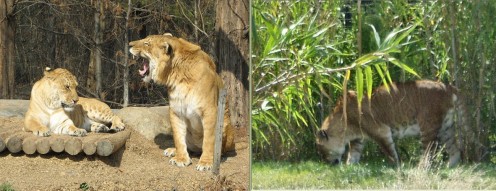
New Species
Can new species come into existence, and, if so, how?
The Bible claims that many new species came into existence during the six days when God was working to create our world.
He created all of the animals and, then, he separately created a pair of humans ~ Adam and Eve ~ to have dominion over them.
If this is true, then no species existed ~ or could have existed ~ before 'the Creation' and no new species have arrived on Earth since 'the Creation'.
So every type of creature that has ever lived ~ give or take the smallish changes allowed for in micro-evolution ~ existed then?
Do we assume that God's days were long enough to allow for the reign of the dinosaurs, before man was created to have dominion over the beasts? ~ And for the reign of other monster beasts, before the dinosaurs came along?
The ability for new 'species' to form seems to be the real stumbling block for Creationists. They can accept evolution within a species, but not evolution that results in new species.
This word 'species' ~ is so important, yet the definition of a species is controversial in itself.
Maybe it doesn't have to be a stumbling block???
The Species Solution?
There seems to be some confusion as to what exactly a 'species' is.
Certainly it is a sub-division of a genus, but within that identity, what constitutes a different species?
The assumption is that two or more species, within a genus, will be similar, but not so similar that they can mate; or, if they can mate, that they will not be able to give birth to healthy living young; or, if they can give birth to healthy living young, that the young will be sterile.
Yet different species of bear, as we have seen, have, indeed, given birth to healthy young ~ which have, in turn, reproduced.
One thing is sure about 'the species' ~ it is a stumbling block for Creationists, which prevents them from accepting even the possibility that evolution may be true.
But, since the definition of the species seems to be somewhat arbitrary, why don't we just remove it?
Why not just say that different species are so called because they show noticeable difference ~ but that those differences may not be so huge that they prevent interbreeding.
We could also say that, when a species evolves into another species, it is only given a new name to indicate that substantial changes have taken place, but not changes that would be beyond the definition included in 'micro-evolution'? The resulting creatures may or may not then be able to interbreed, depending on the amount of genetic change.
One thing that must be clarified, when we talk of species inter-breeding, or evolving into new species, is that we are only ever talking about very closely related animals.
A polar bear might mate with a brown bear, and, maybe, at some stage, there may evolve a new type of bear; but a polar bear will not even mate with a creature as closely / distantly related as a panda ~ and there can be no doubt in anyone's mind, when looking at the two, that they are related.
So we are not, and never would be, considering a tiger mating with a camel, for example, or a zebra evolving into a cat.
Primate Book Covers

Colin Tudge
Have you heard the one about
The ape who turned into a man!?
I keep hearing this joke, from Creationists on the Internet (~ at least, I think that it is meant as a joke):
One day, an ape wakes up, goes to the water hole, looks at his reflection, and discovers that he has turned into a human!!!
Alternatively ...
One day, a female ape gives birth, and discovers, to her amazement, that she has produced a human baby!!!
Actually, I don't think that they are jokes, as such. I think that creationists actually believe that evolutionists actually believe that this can actually happen, or, indeed, already has happened!
I have even heard it said that evolutionists believe that fish can give birth to birds! (The mind boggles.)
Let us be clear. This is nonsense.
No-one in their right mind believes that an ape can simply turn into a human, or that an ape can give birth to a human.
No-one in their right mind believes that a fish can give birth to a bird.
Creationists don't believe it ~ but neither do evolutionists!
To clarify: evolutionists do not believe that an ape can turn into a human, that an ape can give birth to a human ~ or that a fish can give birth to a bird.
David Attenborough
Birds, Bees and Other Beasts: Back to the Beginning - and to David Attenborough.
In his documentary about Darwin ~ 'Charles Darwin and the Tree of life' ~ Attenborough explains early evolution. (Steve Jones also worked on this programme.)
In the very earliest days of life, hundreds of millions of years ago, simple microscopic cells were formed. They lived in the sea.
Some single cell creatures still exist, of course, but some of those cells split and replicated.
Some formed chains and developed into algae, while some formed hollow balls, which then collapsed, to become the first multi-cell creatures ~ like sponges.
Others developed a stiffening 'rod' in their bodies ~ and they also developed sense organs at the ends of their bodies. Later they developed bone on this 'rod', and a skull with a jaw, and fins, and muscles. They became fish.
About 450 million years ago, some of these creatures were able to crawl onto the land. Their bodies developed flaps, which became wings, and they developed into insects.
About 375 million years, some of the early fish gulped air at the surface and their fins evolved into legs. They crawled onto the land. but they had to return to the sea to lay eggs. These were amphibians.
Some of these, though, developed scaly skins and the ability to lay their eggs on land. These were reptiles ~ ancestors of tortoises, lizards, crocodiles and, of course, dinosaurs.
It was only 65 million years ago that a world disaster caused the death of much life on earth. All dinosaurs became extinct, except for one branch ~ where the scales had evolved into feathers. These were early birds.
At that time, some small furry creatures began to come into their own in the almost vacant landscape. They could survive almost anywhere. They were early mammals ~ which evolved, slowly but surely, into us.
Source: 'Charles Darwin and the Tree of Life'
Archeaopteryx and Birds
Birds and Dinosaurs - and Controversy??
Back in 1966, when I was ten, I produced a project on birds, for a school subject. I remember reading that some scientists believed that birds were descended from dinosaurs. Amazing! Certainly I could see a resemblance! I included that information in my work. (I was fascinated, but not shocked ~ so I was perfectly open to evolutionary theory at a young age. My father had probably discussed it with me before this.)
Since then, this 'knowledge' has become more widespread and can be found in various books, museums, documentaries, websites, etc.
Bird-like dinosaur fossils have certainly been found. The huge 'Gigantoraptor' was found within the last few years. Here are some excerpts from an article on the subject:
‘Remains of a colossal, surprisingly bird-like dinosaur have been uncovered in Inner Mongolia, China, scientists say.
‘The animal, which lived in the Late Cretaceous period, about 70 million years ago, is thought to have weighed about 1,400 kilograms (3,000 pounds). That’s surprising, paleontologists said, because most theories suggest carnivorous dinosaurs got smaller as they evolved to become more bird-like.
‘The dinosaur ... has been classed as a new species and genus.’
June 13, 2007 ~ Courtesy Nature and World Science staff.
http://www.world-science.net/othernews/070613_gigantoraptor.htm
Wonderful artist's impression, here:
http://www.world-science.net/images/fullscreen/gigantoraptor-full.jpg
Archaeopteryx and Hoatzin

Newly Hatched Hoatzin - Showing Claws on Wings
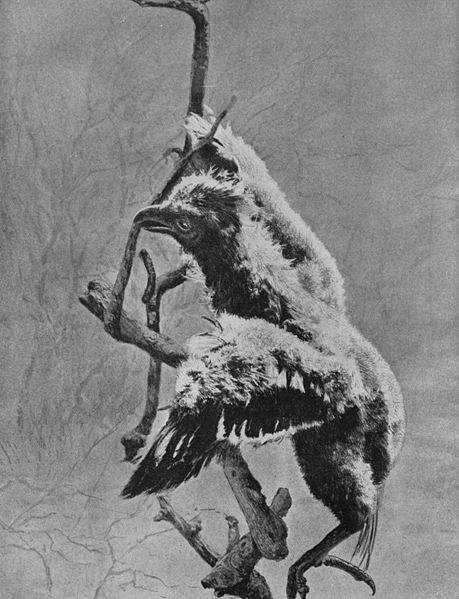
Feathered Friends
This from About.com:
'While it can't be flatly stated that every single genus of raptor had feathers, enough fossils have been unearthed bearing evidence of this unmistakably bird-like trait to lead paleontologists to conclude that feathered raptors were the norm, rather than the exception.
http://dinosaurs.about.com/od/typesofdinosaurs/a/raptors.htm
So certain birds and dinosaurs looked alike and certain dinosaurs were covered in feathers ~ what else?
Well, there are fossilised bodies of a creature that seems part bird and part reptile!
In his documentary about Darwin, Attenborough showed viewers the first example ever found. It was discovered in Bavaria, only two years after the publication of Darwin's 'On the Origin of Species'.
This creature has been named the 'archaeopteryx' and it is considered to be a major link between the reptile/dinosaur and the bird.
It had feathered wings and tail, but no beak. Instead, it had jaws and teeth. It had bones in its tail and claws on its wings.
But ~ regarding the archaeopteryx, and the idea of 'missing links', Richard Dawkins notes:
To put up a single famous fossil like archaeopteryx panders to a fallacy. In fact, for a large number of fossils, a good case can be made that every one of them is an intermediate between something and something else.' [Greatest Show on Earth]
There is a bird living, today, that is born with claws on its wings! It is a beautiful creature, named the hoatzin.
Books - Archaeopteryx

Questioning Evolution
Archaeopteryx
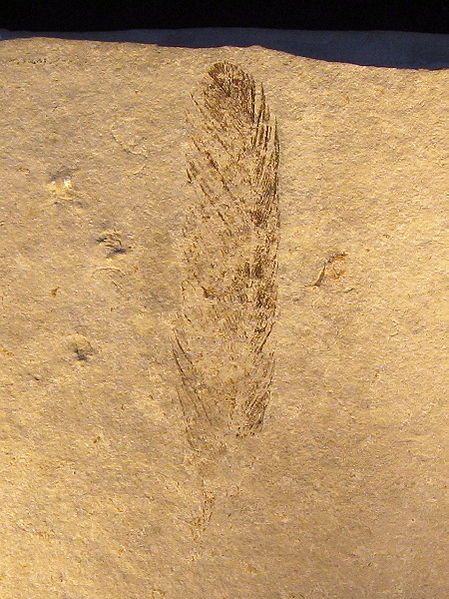
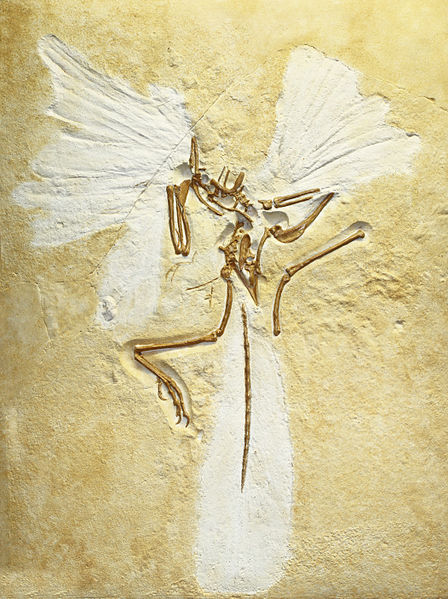

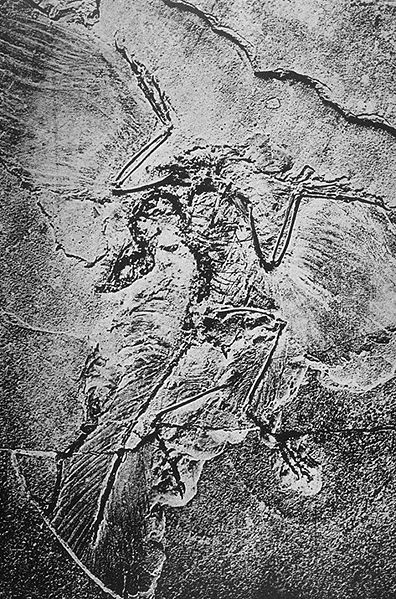
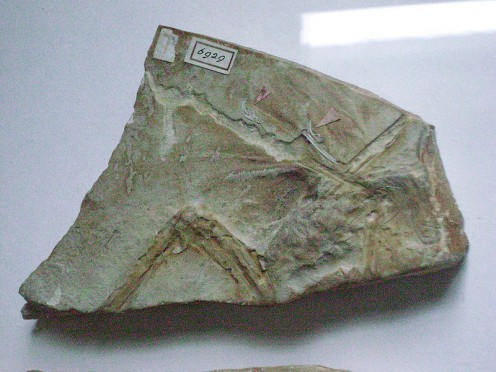
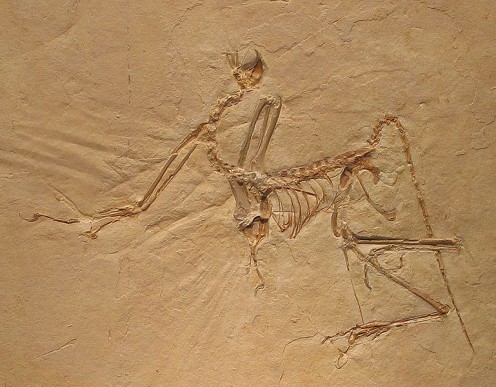
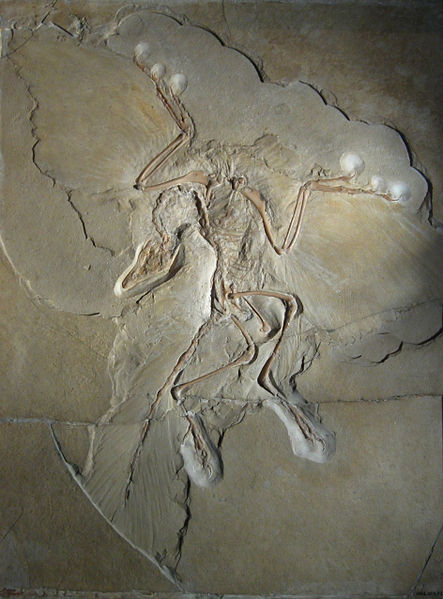
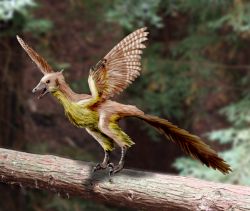
The Bird - Dinosaur Controversy
So where is this bird-dinosaur controversy?
'Researchers at Oregon State University have made a fundamental new discovery about how birds breathe and have a lung capacity that allows for flight – and the finding means it's unlikely that birds descended from any known theropod dinosaurs'.
'John Ruben, OSU professor of zoology, [said]. "This discovery probably means that birds evolved on a parallel path alongside dinosaurs, starting that process before most dinosaur species even existed."
‘Warm-blooded birds need about 20 times more oxygen than cold-blooded reptiles, and have evolved a unique lung structure' ... “This is fundamental to bird physiology," said Devon Quick, OSU zoology instructor'.
'The implication is that birds almost certainly did not descend from theropod dinosaurs, such as tyrannosaurus or allosaurus.'
'There are some similarities between birds and dinosaurs, and it is possible, they said, that birds and dinosaurs may have shared a common ancestor, such as the small, reptilian "thecodonts," which may then have evolved on separate evolutionary paths into birds, crocodiles and dinosaurs'.
Quick said: "We aren't suggesting that dinosaurs and birds may not have had a common ancestor somewhere in the distant past. That's quite possible and is routinely found in evolution. It just seems pretty clear now that birds were evolving all along on their own and did not descend directly from the theropod dinosaurs, which lived many millions of years later."
[Quotes from: ScienceDaily (June 9, 2009) ]
There is another article on the subject here:
'Bird-from-Dinosaur Theory of Evolution Challenged: Was It the Other Way Around?'
'ScienceDaily (Feb. 10, 2010) — 'A new study just published in the Proceedings of the National Academy of Sciences provides yet more evidence that birds did not descend from ground-dwelling theropod dinosaurs ...'
"We're finally breaking out of the conventional wisdom of the last 20 years, which insisted that birds evolved from dinosaurs and that the debate is all over and done with," Ruben said. "This issue isn't resolved at all. There are just too many inconsistencies with the idea that birds had dinosaur ancestors, and this newest study adds to that."
"Raptors look quite a bit like dinosaurs but they have much more in common with birds than they do with other theropod dinosaurs such as Tyrannosaurus," Ruben said. "We think the evidence is finally showing that these animals which are usually considered dinosaurs were actually descended from birds, not the other way around."
*
Then there's this:
'New dinosaur discovery solves evolutionary bird puzzle'
By Doreen Walton, Science reporter, BBC News, 28 January 2010
'A newly discovered fossil has shed light on why a group of dinosaurs looks like birds, say scientists.
'Haplocheirus sollers may not be as charismatic as T. rex or as agile as a pterodactyl but it's thought to solve a long standing puzzle.
'Researchers believe its short arms and large claw show how bird-like dinosaurs evolved independently of birds.
'The 3m-long skeleton, found on an expedition to China's Gobi desert, is described in the journal Science.'
http://news.bbc.co.uk/1/hi/sci/tech/8485263.stm
Not being a scientist, I do not know the answers to this mystery. But it fits with what science is: a constant work in progress as new data is regularly discovered and processed.
So, it is possible that, rather than birds descending from dinosaurs, both dinosaurs and birds descended from an earlier dinosaur-like-bird-like creature. I think that this would still make birds the nearest relatives to dinosaurs alive today.
I found this interesting ~ and surprising ~ comment from Richard Dawkins:
"... some reptiles as conventionally recognised (eg crocodiles and dinosaurs) are closer cousins to birds .. than to other 'reptiles' (eg lizards and turtles). Indeed, some dinosaurs are closer cousins to birds than they are to other dinosaurs." [The Greatest Show on Earth]
*
Web reference: 'Bird-from-Dinosaur Theory of Evolution Challenged: Was It the Other Way Around?'
'ScienceDaily (Feb. 10, 2010)
http://www.sciencedaily.com/releases/2010/02/100209183335.htm

Evolution: The Grand Experiment
Another Look at Dogs and Bears
We may recall that bears are of the Family Ursidae, and that the Ursidae are of the Suborder Caniformia.
Also that that Pinnipeds ~ ie. seals, etc ~ belong to the Suborder Caniformia.
And, while the Red Panda does not belong to the 'Ursid' family, as the Giant Panda does, they do both belong to the same suborder of the Carnivora ~ the 'Caniformia'.
Since dogs are 'Canine', it is not surprising to learn that the Family 'Canidae' also belong to the 'Caniformia'.
The canids include wolves, dogs, foxes, etc. The Canidae family is divided into two 'tribes': Canini ('dogs') and Vulpini ('foxes').
*
Now, as I suggested, let us try to forget the hurdle that may ~ or may not ~ be a 'species'.
Even Creationists accept that animals can evolve, adapt and change, as long as it is only under the heading 'micro-evolution', so let us consider that creatures may have been 'micro-evolving' for hundreds, thousands, millions of years.
We can see just how different a poodle is from a wolf, so the amount of change that can occur over such a huge amount of time must be phenomenal, mustn't it?
We can, also, surely, see that a panda and a polar bear are related and that ~ having had the time to do so ~ they have descended from the same ancestor?
The family relationship seems obvious, because they are so alike ~ and DNA proves the point.
But, unlike brown bears and polar bears, which can mate and reproduce, pandas and polar bears have evolved to be so different that they cannot mate ~ but they are still similar enough to be, quite obviously, related.
Let us take some steps backwards. The Ursids, the canids, the pinnopeds, etc, all belong to the Suborder Caniformia. I agree that it is very difficult with seals, but let us just try to imagine what the ancestors of a bear, or a panda, or a red panda, or a wolf, or a fox, might have looked like several hundred, or even thousands of years ago.
It is accepted, by creationists as well as evolutionists, that animals can evolve to a degree. I am not suggesting that anyone imagine a wolf giving birth to a bear, or a panda turning into a fox. I am just asking that Creationists consider the small changes that might occur, from generation to generation, if one went back far enough, for long enough.
Is it not possible that, at some stage, the ancestors of the bear, or the panda, or the red panda, or the wolf, or the fox, or, indeed, all of them, might not have looked alike? That their DNA might not have been quite similar? That they might not have shared some ancestors!?
This is what seems likely. This is why they are all members of the Suborder Caniformia.
Whale Ancestor, Ambulocetus, and Hump Back Whale

Now Something About Whales
I learned something surprising about the evolution of whales, whilst reading Steve Jones's book; 'Something Like a Whale ~ The Origin of species updated'.
Before they took to the sea, the ancestors of the whales were land creatures. Steve Jones writes that 'the distant ancestors of whales were hyena-like beasts'. Their DNA shows that, of animals alive today, they seem to be closely related to pigs and deer ~ and particularly to hippopotamuses.
Fossil evidence has been found for most of the steps from land animal to sea-water whale.
Hippo Ancestor, Anthracotherium, and Hippopotamus

The Supernatural and The Soul
If we are so close to chimpanzees, and if we are descended from and related to, less advanced humans, how do we explain 'the supernatural' and its place in our story?
Do we have souls?
Did our ancestors have souls?
Do chimpanzees have souls?
What about other animals?
Intelligence and the Human Difference
There is something that intrigues me.
I know that we humans are more closely related to chimpanzees than chimpanzees are to gorillas. I find that quite amazing, because, it looks quite obvious to me that we humans are actually very different from other animals ~ including our closest relatives, the other primates.
So we are, for some reason, very different from our closest animal relatives. What is the explanation?
I have read theories.
~ It is because we are especially made, by God, in the image of God.
~ It is because we have been modified by advanced alien cultures.
~ Etc, etc
~ It is because we ate relatively large amounts of meat.
I do not know what the answer is.
It is because of life's mysteries ~ ones like this ~ that I am agnostic, rather than an atheist.
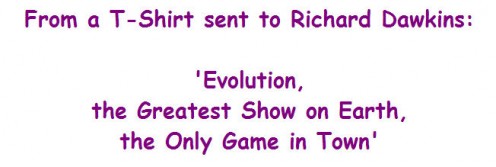
How Important is the Theory of Evolution?
From my reading, it would appear that several scientists consider it to be hugely important.
'David [Attenborough] concludes that Darwin's great insight revolutionised the way in which we see the world ..' [ http://www.bbc.co.uk/programmes/b00hd5mf ]
‘Thomas Henry Huxley proclaimed the Origin of Species to be “the most potent instrument for the extension of the realm of knowledge which has come into man’s hands since Newton’s Principia”. Ernst Mayr .... asserted that the Origin of Species triggered the greatest paradigm shift in the history of science. .... Stephen Jay Gould ... called the theory of evolution one of the half dozen most important ideas in the entire history of Western thought. ... Daniel Dennett called evolution the most dangerous idea in the history of science.’
[Donald R Prothero ~ ‘Evolution: What the Fossils Say and Why It Matters’]
Steve Jones
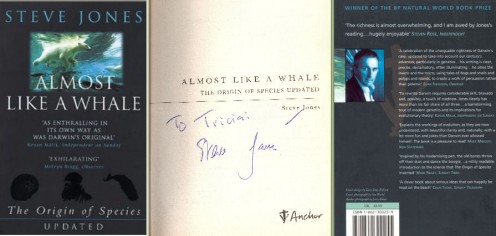
The 'Chemical Soup' and The Very Origins of Life
Darwin didn't publish very much about life's ultimate origins. He wrote:
‘Probably all the organic beings which have ever lived on this earth have descended from some primordial form, into which life was first breathed’
But ...
'Secretly, Darwin did have his own ideas about how life kicked off; he thought that life probably began spontaneously from the chemical soup that existed as the earth began to calm down a bit following its violent birth.
'He wrote to his friend Joseph Hooker expressing this idea:
"But if (and Oh! What a big if!) we could conceive in some warm little pond, with all sorts of ammonia and phosphoric salts, lights, heat, electricity etc., present that a protein compound was chemically formed ready to undergo still more complex changes"
[Quote from University of Cambridge website: http://darwin200.christs.cam.ac.uk/pages/index.php?page_id=f8]
And the idea cannot be ignored. It is implicit in the Theory of Evolution.
If we, and all of the other animals, evolved from early simple creatures, then where did those early creatures come from?
There are suggestions and hypotheses, but nothing certain ~ not yet!
Creationists, of course, believe that all of life was brought about by God
Some people suggest that life arrived on Earth from Outer space ~ perhaps via a meteorite.
Another possibility is that there was a chemical or electrical reaction of some kind.
'In the 1950's, two biochemists conducted an experiment which showed that certain molecules of life (amino acids) could form spontaneously when the conditions of Earth's early atmosphere were recreated in the lab.'
Science or Myth????!!
Science Does Not Have All Of The Answers!
I was watching Irish comedian Dara O Briain, recently. As part of his routine, he was talking about science.
It went something like this:
He commented on those people who keep saying: 'Oh, but science doesn't have all of the answers!'
"Of course science doesn't have all the answers", he retorted. "If science thought that it had all of the answers ~ it would stop!"
He is right, of course ~ science is an ongoing process.
Evolution science is not perfect. It will continue to be tweaked as new discoveries are made and new hypotheses tested, but that does not mean that evolution isn't a correct interpretation of the development of life.
Dara O Briain, by the way, studied maths and theoretical physics at University College Dublin.
The Making of Mankind
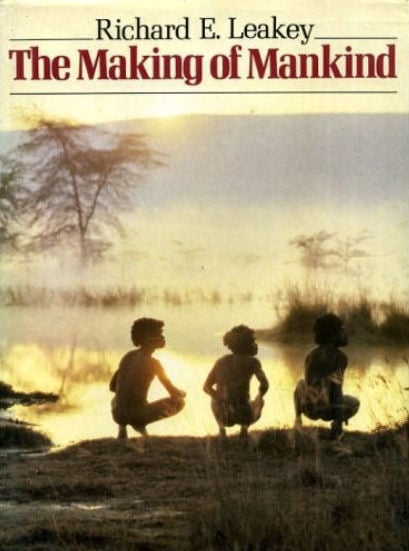
Richard E. Leakey Quotes:
"Humans have ... [an] intense curiosity about our relationship with the world around us."
"There is "an apparently universal uncertainty about where we come from. The desire to remove that uncertainty is very strong indeed: it is what the great theologian Paul Tillich referred to as 'the ultimate concern'."
[Richard E. Leakey: 'The Making of Mankind']
'An evolutionary perspective of our place in the history of the earth reminds us that Homo sapiens sapiens has occupied the planet for the tiniest fraction of that planet's four and a half thousand million years of existence. In many ways we are a biological accident, the product of countless propitious circumstances.'
[Richard E. Leakey ~ Co-author with American science writer Roger Amos Lewin (1946), Origins: What New Discoveries Reveal about the Emergence of our Species and its Possible Future(1977)]
"Our self-awareness impresses itself on us so cogently, as individuals and as a species, that we cannot imagine ourselves out of existence, even though for hundreds of millions of years humans played no part in the flow of life on the planet. ... Our inability to imagine a world without Homo sapiens has a profound impact on our view of ourselves; it becomes seductively easy to imagine that our evolution was inevitable. And inevitability gives meaning to life, because there is a deep security in believing that the way things are is the way they were meant to be."
[Richard E. Leakey: 'The Sixth Extinction]
Richard Dawkins Quotes
"Evolution could so easily be disproved if just a single fossil turned up in the wrong date order. Evolution has passed this test with flying colours."
*
"Why would an all-powerful creator decide to plant his carefully crafted species on islands and continents in exactly the appropriate pattern to suggest, irresistibly, that they had evolved and dispersed from the site of their evolution?"
[Richard Dawkins: 'The Greatest Show on Earth - the Evidence For Evolution']
*
"The theory of evolution by cumulative natural selection is the only theory we know of that is in principle capable of explaining the existence of organized complexity."
*
"We admit that we are like apes, but we seldom realize that we are apes."
[Richard Dawkins]
*
"This book is my personal summary of the evidence that the 'theory' of evolution is actually a fact – as incontrovertible a fact as any in science."
[Richard Dawkins, regarding his book: 'The Greatest Show On Earth - the Evidence For Evolution']
Robert Winston Quotes:
'Lord Robert Winston has renewed his attack on atheist writers such as Richard Dawkins, Daniel Dennett and Christopher Hitchens, whose arguments he said were "dangerous", "irresponsible" and "very divisive".
'The science populariser and fertility expert said that the more bombastic arguments of atheist scientists were making dialogue between religion and science more difficult'.
[ http://www.guardian.co.uk/science/blog/2008/sep/12/robert.winston ]
*
Robert Winston:
“In 1871, Charles Darwin wrote that he thought that our earliest ancestors originally came from Africa. He believed this because our closest surviving relatives ~ apes, gorillas and chimpanzees ~ were only found living in that part of the world.
"This view was highly controversial at the time. No matter how liberal most Victorian paleoanthropologists were, they resented the idea that all humans might have derived from black Africans ...”
[Walking with Cavemen]
Desmond Morris
Desmond Morris Quote:
"Why on earth should the hunting ape have become a naked ape? .... Exactly how did it occur and how did it help the emerging ape to survive?"
From Morris's book:
'The Naked Ape'
By DESMOND MORRIS
'Two centuries on, a salute to Charles Darwin: Hero for our age' ~ '... Britain's leading anthropologist toasts Darwin, born 200 years ago ...' ~ By Desmond Morris
'There is a strange object sitting on my desk as I write. It is a shiny sphere of fossilised, primeval slime. Known technically as stromatolites, this blue-green slime was the original ooze from which all life on this planet evolved.
'This painfully slow process began about 3,000 million years ago and has led, ultimately, to us, the extraordinary human species.
'Whenever my gaze happens to fall upon my lump of fossilised slime I experience a strange sensation, a deep respect, for I am looking at my most ancient ancestor.
'Yours, too, unless you still believe in the tale of Adam and Eve and a talking serpent in the Garden of Eden.'
From an article in 'The Daily mail'
Source:
http://www.dailymail.co.uk/news/article-1101985/Two-centuries-salute-Charles-Darwin-Hero-age.html#ixzz1ButG5lfc
David Attenborough Quotes
“... there's an awful lot about evolution that we don't understand”
*
“The theory that the first woman was made out of the rib of Adam - now that is quite a difficult one to believe"
David Attenborough Interview
“I rather wish I'd been brought up a creationist who had a Damascene moment: ‘Yes! Now I see it.' But it always seemed clear that we were related to monkeys.”
'What thrills Attenborough is that Darwin's theory is being bolstered by modern science of which Darwin had no inkling, such as genetics.'
'... many Christians have made their peace with [Darwin]. “The Pope has. The Archbishop of Canterbury has. They all say , "Yes, of course, the Book of Genesis is only a myth, a creation myth. ...." That's what civilised religious people say.'
'His beef is with those who want to teach creationism or its offshoot “intelligent design” .... “That is terrible. That is really terrible,” .... “... it's a human disgrace that you don't recognise the difference between these things”....'
“People write to me that evolution is only a theory. Well, it is not a theory. Evolution is as solid a historical fact as you could conceive. ..... the historical reality that dinosaurs led to birds and mammals produced whales, that's not theory.”.....'
*
Some quotes from an article in 'The Times', January 22, 2009, by Damian Whitworth
'David Attenborough on Charles Darwin' ~ 'On the 200th anniversary of the great scientist's birth, Sir David Attenborough muses on how he changed the world'.
Source / Further Reading:
http://www.timesonline.co.uk/tol/news/environment/article5562484.ece
Pope Benedict

The Pope on Evolution
'Pope Benedict XVI said the debate raging in some countries ~ particularly the United States and his native Germany ~ between creationism and evolution was an “absurdity,” saying that evolution can coexist with faith.
'The pontiff ... said that while there is much scientific proof to support evolution, the theory could not exclude a role by God.'
“They are presented as alternatives that exclude each other,” the pope said. “This clash is an absurdity because on one hand there is much scientific proof in favor of evolution, which appears as a reality that we must see and which enriches our understanding of life and being as such.”
'He said evolution did not answer all the questions: “Above all it does not answer the great philosophical question, ‘Where does everything come from?’”
These are quoters from article by Lorenzago Di Cadore, Italy ~ 7/25/2007
msnbc.com news services
Steve Jones - on Darwin's Thesis
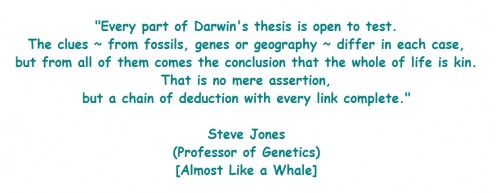
Roger Lewin (Colleague of Richard Leakey)
Is This About Science and Man, Or The Bible And God?
I wonder; how far do those who claim to be Creationists actually look into evolution?
Many of them seem to think that evolutionists actually believe that apes turn into humans.
Many of them do not seem to see that the 'micro-evolution' that they accept, if left to its own devices, will lead to the 'macro-evolution' that they seem to abhor.
Many of them seem not to know what a scientific theory is, yet they feel qualified to ridicule and disprove this one.
Is this really about Evolution at all ~ or is it really just about protecting belief in the Bible and everything in it?
School Lessons - Now and Henceforward???
I believe that science should be taught in Science lessons and that religious beliefs should be taught in Religious Education lessons By this, I mean that pupils should be taught about different religions, not that they should be instructed in religious dogma.
I actually think that it is a good idea to consider Creationism, either in the relevant Science lesson, or in a class especially set up and devoted to the subject ~ not as a counter* to evolution, but simply because children will know about it and wonder about it, and they should be given the chance to think about, and discuss, the different ways that different people perceive this subject.
*Some Christians ~ certainly not all ~ seem to think that Creationism and Evolution should be given equal weight when 'origins' are being considered in science classes.
I do not agree. This would be like giving equal weight to the story of 'Thor's Hammer' in a science lesson on thunder and lightning.
Certainly they should not be taught, in school, that Creationism is true ~ simply that this is the explanation given in the Bible, and that it is accepted as true by some Christians, and as a symbolic allegory by others.
Gregor Mendel
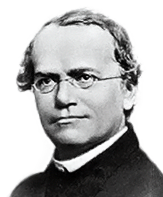


Gregor Mendel and Genetics
Mendel's discoveries have lent a lot of support to Darwin's 'theory' ~ to the extent that what might, at the time, have been considered a hypothetical theory can now be considered a scientific theory.
Gregor Mendel, 19th century Austrian monk and researcher, is known as the ‘father of modern genetics’. He was born in July 1822 and died in January 1884.
Mendel studied pea plants and discovered that different traits were inherited from the ‘parent’ plants and that this inheritance followed certain ‘laws’.
However, the importance of his work was not realised until this information was ‘re-discovered’ in the twentieth century, to become the foundation of genetic research.
Darwin - Mocked as an Ape - With Fellow Primates
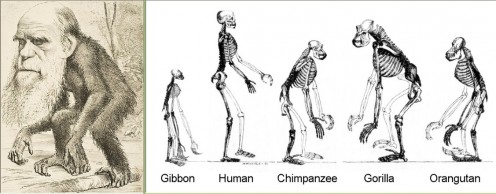
Charles Darwin
Charles Darwin
Probably the most famous name in the field of 'evolution' is that of 'Charles Darwin'.
Charles Darwin was born in Shropshire, on 12th February, 1809 and he died 19th April, 1882.
As a young man, he travelled on the Beagle ~ a five-year voyage. He was ships naturalist and companion to the captain.
In the Galapagos Islands, he noted differences in similar species of creatures. He collected samples and kept numerous notes. His findings helped him to develop his own theory of evolution, based on natural selection. (His grandfather, Erasmus Darwin, had already arrived at his own theory of evolution.)
He did not publish his writings for many years, and only then because fellow scientist, Alfred Russel Wallace, with whom he corresponded, had arrived at the same theory and was about to make it public.
Summaries of both men’s works were read out at the same meeting of the Linnaeus Society. At the time there was little response, but Darwin’s book ‘On the Origin of Species’, finally published in 1859, was to become one of the most famous and controversial ever.
Darwin became a Fellow of the Royal Society, as did other members of his somewhat illustrious family.
His maternal grandfather was Josiah Wedgwood, the famous pottery owner and founder member of the Lunar Society
His paternal grandfather was Erasmus Darwin, the well-known inventor, poet abolitionist and physiologist (he was invited by King George III to be his personal physician) and founder member of the Lunar Society.
Francis Galton, polymath, meteorologist, and founder of eugenics, who coined the phrase: ‘nature versus nurture', was his half-cousin.
His uncle, Samuel Galton, belonged to the very successful Birmingham gun-making, iron mongering and banking company, and was also a member of the Lunar Society.
He married his cousin, Emma Wedgwood.
Wallace and Darwin
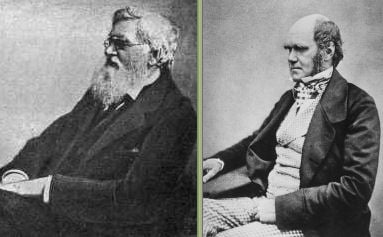
Most Biologists Support Darwin
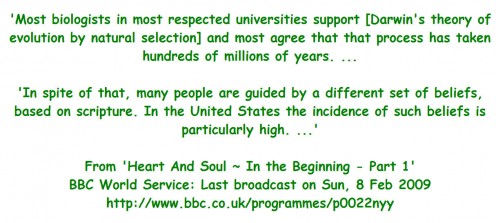
J B S Haldane
From Single Cell To Complex Human??!!
In Richard Dawkins’ book, ‘The Greatest Show on Earth’, I came across the story of a lady, who challenged evolutionist, Professor JBS Haldane, at one of his lectures.
She found it hard to believe that, even given all of the time that had been available, a single cell could ever evolve into a complex human ~ with all that this involves.
Apparently, Haldane replied:
“But Madam, you did it yourself, and it only took nine months".
From Single Cell To Baby!

Human Origins Etc
Walking With ...
About The Leakey Family
Summary, Comment and Conclusion
Through this hub I have tried to explain and illustrate a bit about both evolution and creationism ~ and related subjects ~ and I hope that they will show why and how I accept evolutionary theory as true.
I have looked at how genetics works and how the subject throws light on evolution. I have considered some early 'relatives' and have indicated that there is plenty of fossil and DNA evidence for their existence and for their relationship with modern man. I hope that I have also shown just how closely related we are to our cousins, the chimps, gorillas, etc.
I have thrown in some relevant quotes, which I found useful and interesting. I hope that they, too, will help to explain what I think and why.
To summarise;
The Bible states that a super-being, whom we know as the Lord God, somehow made ~ possibly by moulding out of clay ~ the very first animals and the very first humans. That human couple ~ Adam and Eve ~ were extremely special, because they were made in the very image of God.
However, if God exists, then, by definition, I think, he will be far, far superior to us and way beyond our knowledge and comprehension ~ and would he really look like us?? Yet, 'we' think that we know about him, because of the Bible.
The Bible is, indeed, an amazing set of early documents, which tell stories, myths, histories, dreams, ideas, religious beliefs and hopes of an ancient tribe.
Other ancient and 'sacred' documents also exist, so I find it hard to understand why anyone should think that this particular book absolutely has to be the correct one. It contains contradictions, and tells of some really unpleasant instances, which God, supposedly, approves of.
God may exist. God may have created life. I don't know. But, if he did, why does it have to be exactly as described in the Bible?
Why cannot 'God' be the spark that ultimately starts off life, for example??
Creationists cannot believe that ape-like creatures could have evolved ~ ever so slowly ~ into humans, yet they can believe that Adam was moulded out of earth and Eve was made out of one of his ribs!! (Like clay and bone Pinocchio-type figures!)
I know which option sounds more credible to me. Just look at some chimpanzees; they are very human-like!
Evolution explains life as it is on Earth today. Very early, very simple creatures evolved, very, very, very slowly into slightly more complex creatures, which evolved very, very slowly into yet more complex creatures, and so on and so forth.
Changes were generally slow and minute, but with some quicker changes from time to time, it seems ~ a result of the natural selection of traits, plus regular mutations. If the mutations were beneficial, then the new traits could also be 'selected' according to the environment.
As I said, change was slow ~ equivalent to the 'micro-evolution' that creationists seem to accept ~ and change was only from one creature to a similar creature. Fish were not turning into birds and neither were they giving birth to birds ~ but, bit by bit, generation by generation, very, very slowly, sea creatures might, indeed, evolve into creatures of the air.
And ape-like creatures might slowly evolve into us! And into apes!
Of course, people do not have to believe this; they are free to draw their own conclusions. It would be a very uninteresting world if everyone believed exactly the same thing.
However, if creationists are going to pass on information to others, regarding their own beliefs, or the conclusions of others, then they must be careful to only pass on correct information, and not to mislead their readers and listeners.
I still find the Bible a fascinating read, and I still seek out ancestors ~ for example, I have been to see the Cro Magnon abri (cave), after which Cro Magnon man was named, and the 'Mousterian' cave at Le Moustier, after which Neanderthal culture was named.
I have found the reading for this hub truly fascinating, illuminating and thought-provoking.
Remember; evolutionists do not believe that an ape can turn into a human, or that an ape can give birth to a human, or that a fish can give birth to a bird, or anything else of that nature!
Your Inner Fish - Neil Shubin
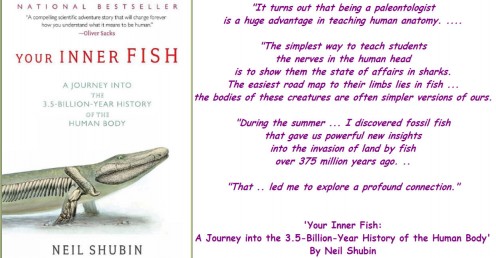
David Attenborough

Sources
There is a huge amount of information available, online, on TV and DVD, in books, etc.
I have found Wikipedia particularly useful for summing up information and for recommending additional reading.
Google is brilliant for searching out additional information, but I do realise that I have to double-check details I may find.
I have lots of books on this and associated subjects, many of which can be found in the Amazon listings. Reading them has informed my conclusions ~ as has watching various documentaries and taking part in relevant conversations.
I have made particular use of:
'Charles Darwin and the Tree of Life'' ~ David Attenborough (DVD)
'The Greatest Show on Earth ~ The Evidence for Evolution' by Richard Dawkins
'Almost Like a Whale' by Steve Jones
'The Making of Mankind' by Richard E Leakey
'Origins Reconsidered' by Richard Leakey and Roger Lewin
'Walking With Cavemen' by John lynch and Louise Barrett
'Natural selection and Heredity' by P M Sheppard
'The Incredible Human Journey' by Alice Roberts
'The Journey of Man ~ A Genetic Odyssey' by Spencer Wells
'Fairweather Eden' by Michael Pitts and Mark Roberts
'In the Shadow of Man' by Jane Van Lawick Goodall
Where I have used websites or articles, I hope that I have given credit as necessary.
I am grateful for the use of Creative Commons images.
My own words remains my copyright (all rights reserved).
It Doesn't Matter???
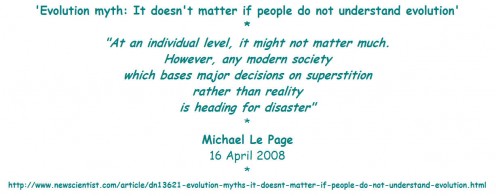
Richard Leakey, David Attenborough, Steve Jones, Richard Dawkins

Human-Like Bonobos
Related Items from Other Hubbers
- If Evolution Were True
- Evidence Of Evolution In The Human Body
- Evolution And Creationism: A Personal Side To The Debate
- The Peacock Effect
- How important is this: A short description of scientific words like theory law and fact.
- Evolution is a Fact, Explained by a Theory
- Darwin and Evolution
- Darwin - The Man Who Killed God
- Science and Religion
Gorilla Walking Like a Human in Kent, England - 1
Gorilla Walking Like a Human in Florida, USA
Relevant Links
- Evolution
- Understanding Evolution
- Can horses mate with zebras? and can humans mate with any other animals?(primates)?
- Clever Monkeys - Introduction - Monkey Intelligence and Culture | Nature
- Evolution
- BBC News - Neanderthal genes \'survive in us\'
- BBC News - DNA identifies new ancient human dubbed \'X-woman\'
- BBC News - Ancient humans, dubbed 'Denisovans', interbred with us
- Jonathan Wells' Icons of Evolution - Review by J. Coyne
- Evolution: 24 myths and misconceptions - life - 16 April 2008 - New Scientist
- Gorilla walks like a man
- BBC News - Charles Darwin's ecological experiment on Ascension isle
- Evolution stops here: Future Man will look the same, says scientist | Mail Online
- Evolution - The Big Picture
- Evolution Entrance
- Evolution Entrance



























![Expelled: No Intelligence Allowed [DVD]](https://m.media-amazon.com/images/I/41sj9fUmS+L._SL160_.jpg)







